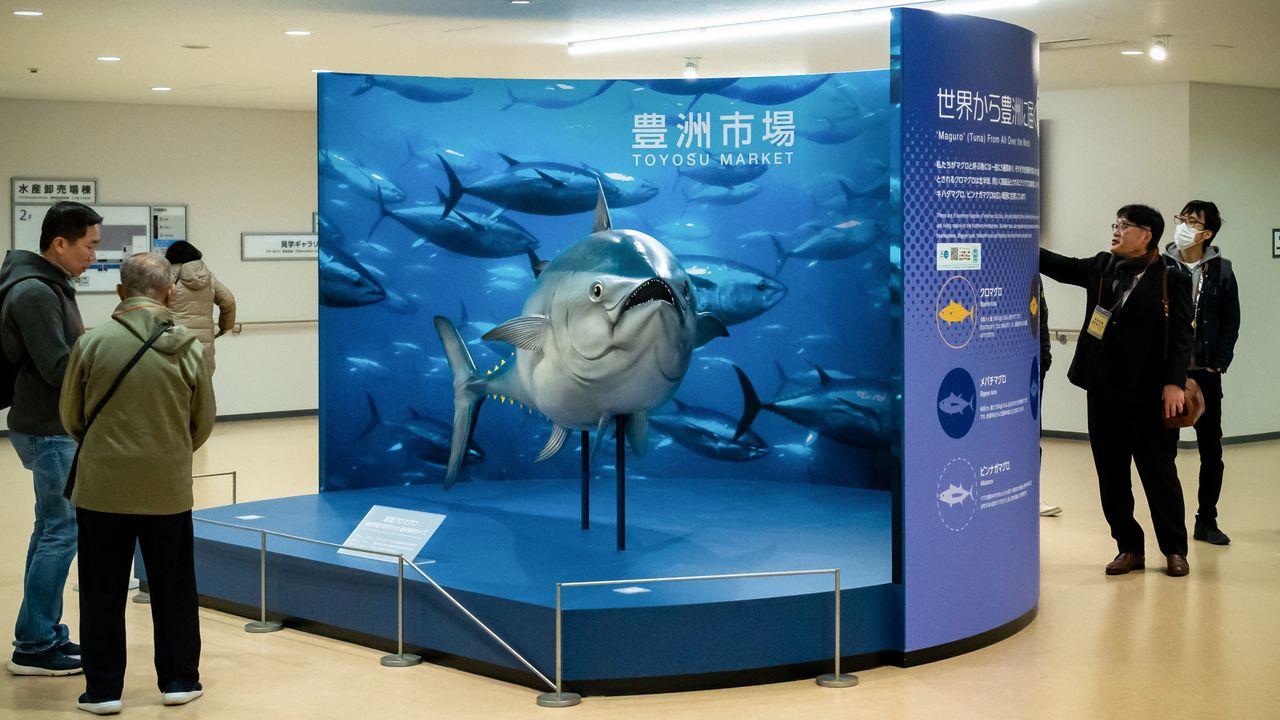
A Visit to Toyosu Market, Tokyo’s “New Kitchen”
Guideto Japan
Travel Food and Drink- English
- 日本語
- 简体字
- 繁體字
- Français
- Español
- العربية
- Русский
Right Off the Train
In October 2018, Japan’s central wholesale food distribution center was relocated from Tsukiji Market in Chūō, Tokyo, where it had stood for the preceding 83 years. The new site, Toyosu Market in the neighboring city of Kōtō, is already a popular tourist attraction, offering free visitor’s tours from 5:00 am to 5:00 pm every day except Wednesdays, Sundays, and holidays.
Prospective tour-takers are recommended to get an early start and ride the Yurikamome train line (which leaves Shinbashi beginning at 5:45 in the morning) to Shijō-mae Station, two stops before the Toyosu terminal station. A series of modern-looking buildings spread away on either side of the station. The market is segmented by roads into three distinct areas: the produce complex, including the Fruit and Vegetables Building, in Block 5; the Fisheries Intermediate Wholesale Market, with its rooftop plaza, in Block 6; and the Fisheries Wholesale Market and management facilities in Block 7.
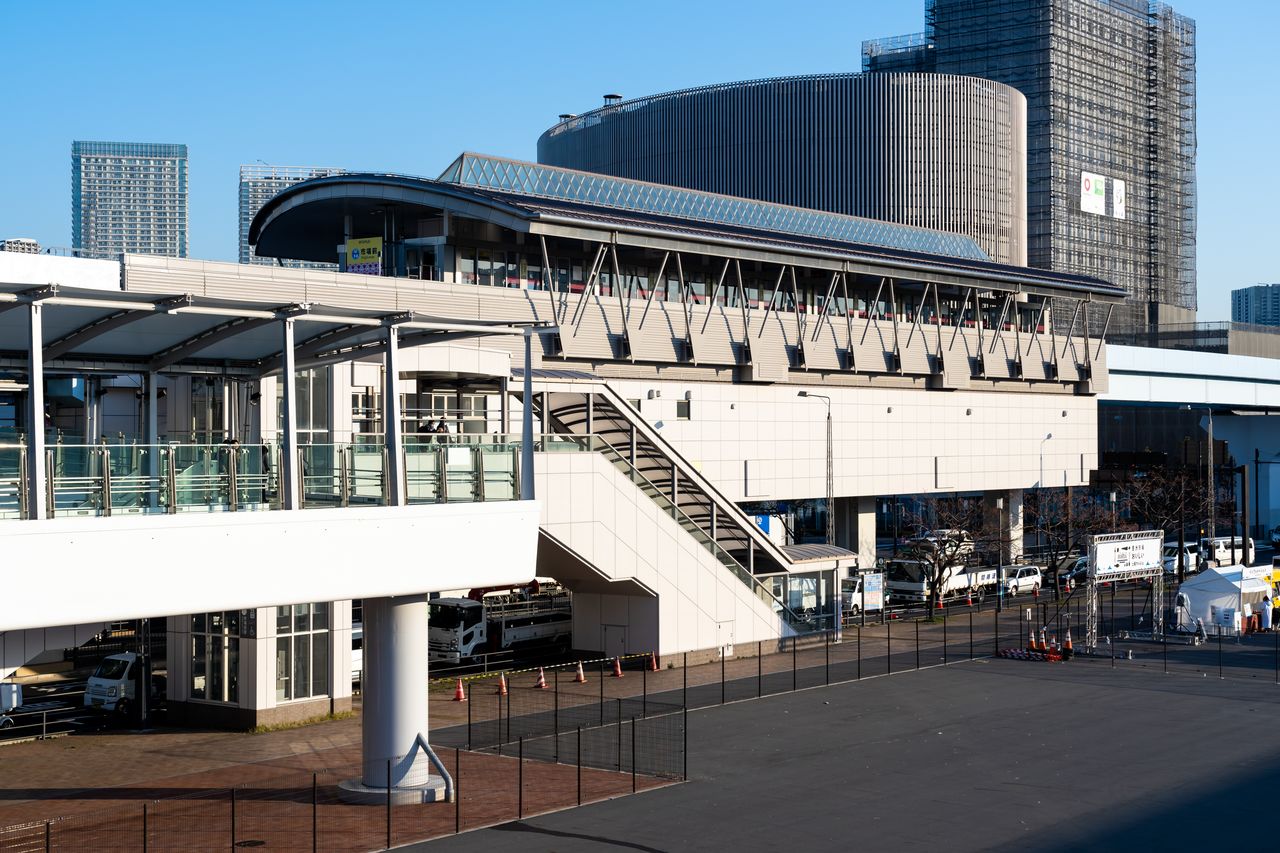
Shijō-mae Station on the Yurikamome train line. Visitors can go to any of the Toyosu Market complexes via covered pedestrian walkways, making it easy to sightsee in any weather.
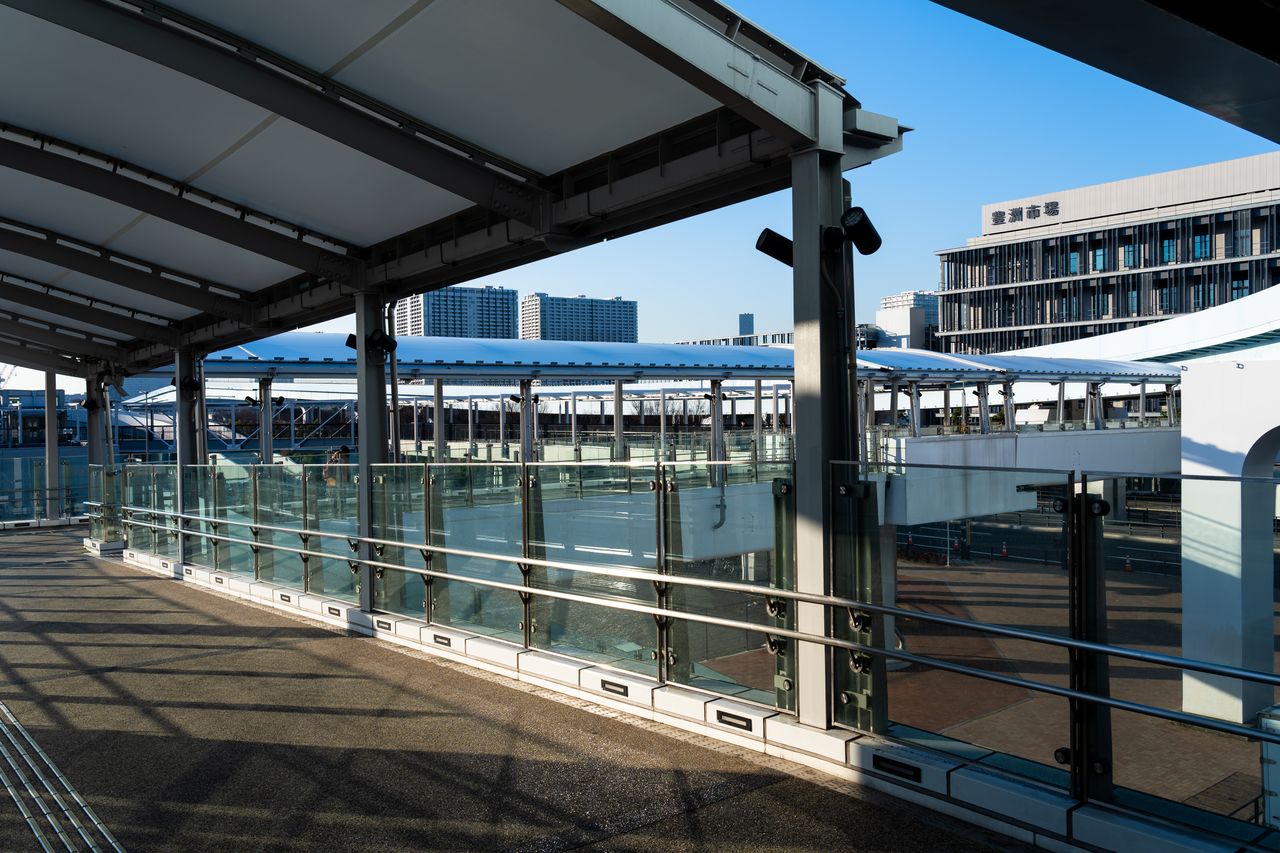
Ahead and to the left as one exits the ticket gates is the Management Facilities Building (at far right in photo), lying along the route to the Fisheries Wholesale Market, where the tuna auctions take place.
Dedicated elevated walkways connect the various complexes at the level of the station’s ticket gates. Ahead and to the left out of the ticket gates is the third-floor entrance of the Managerial Office Complex in Block 7. This structure houses the restaurant area, with six sushi shops, other restaurants serving tonkatsu (deep-fried breaded pork cutlet) and Italian cuisine, and coffee shops, among other dining options. Market staff and other personnel can often be found having breakfast in these restaurants. Beyond is the PR space, offering presentation panels and photographs where visitors can find out about the history and organization of the country’s wholesale markets, as well as aspects that set Toyosu Market apart.
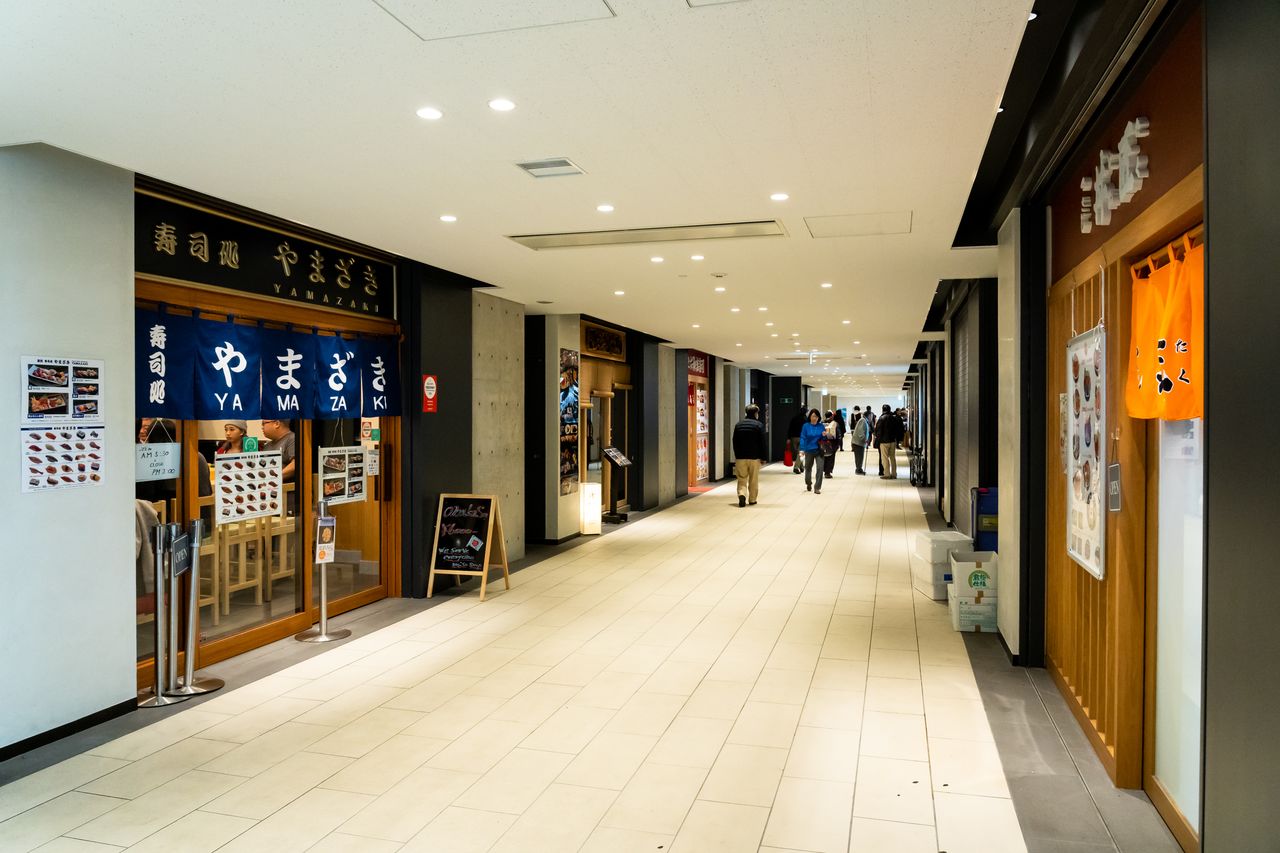
The restaurant area in the Management Facilities Building. The sushi shops can sell out of popular varieties early in the day, so don’t be late.
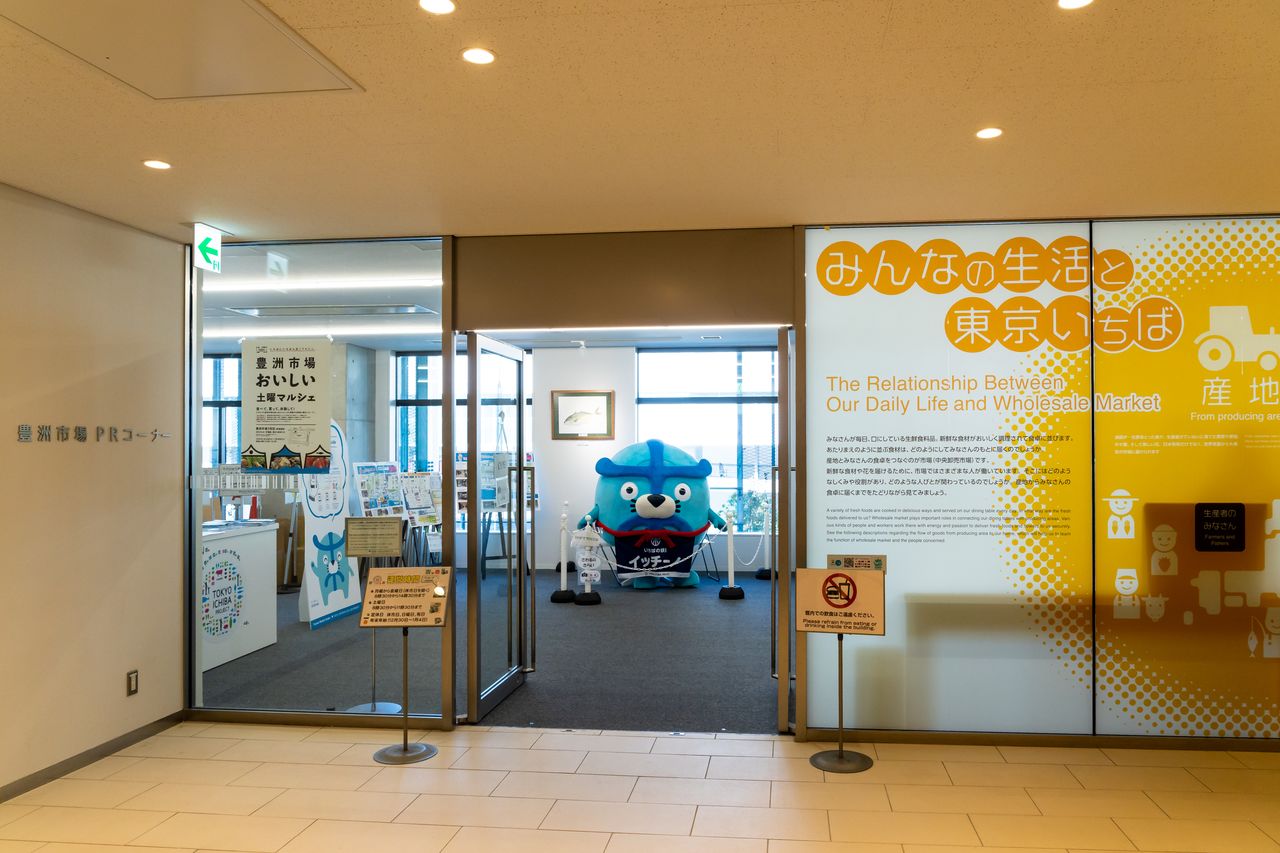
Entrance to the Toyosu Market PR space, where visitors can find out about the organization of the wholesale market.
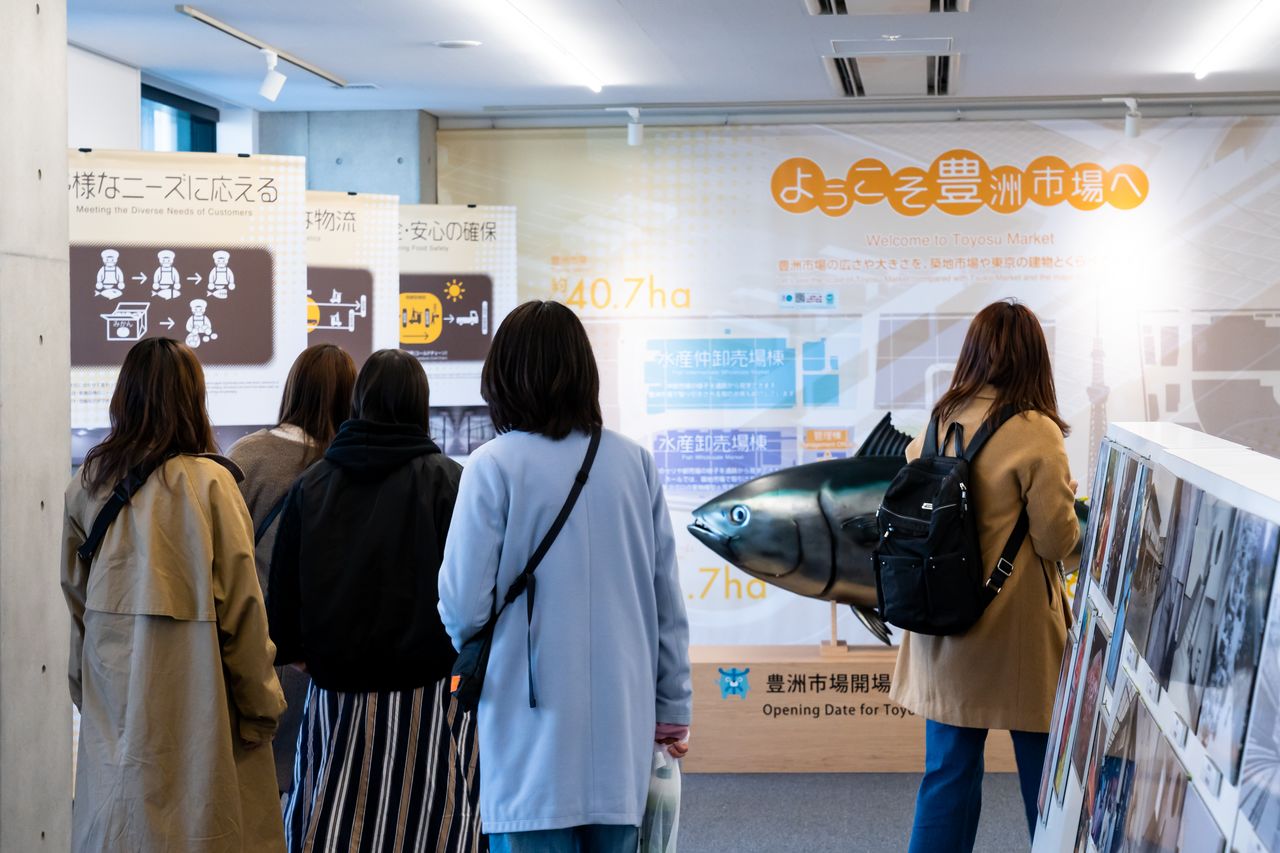
The exhibits in the PR space include photographs dating back to the opening of Tsukiji Market more than eight decades ago.
The Tuna Auctions
Another connecting walkway leads from the third floor of the Management Facilities Building to the second floor of the Fisheries Wholesale Market Building. On display here are a 500:1 scale model of the entire market and a replica of a giant bluefin tuna—a scale reproduction of the largest tuna sold at Tsukiji Market, which was 288 centimeters in length, weighed 496 kilograms, and was delivered in April 1986. Many visitors crowd around this item, resulting in frequent delays as people wait to have their picture taken with it.
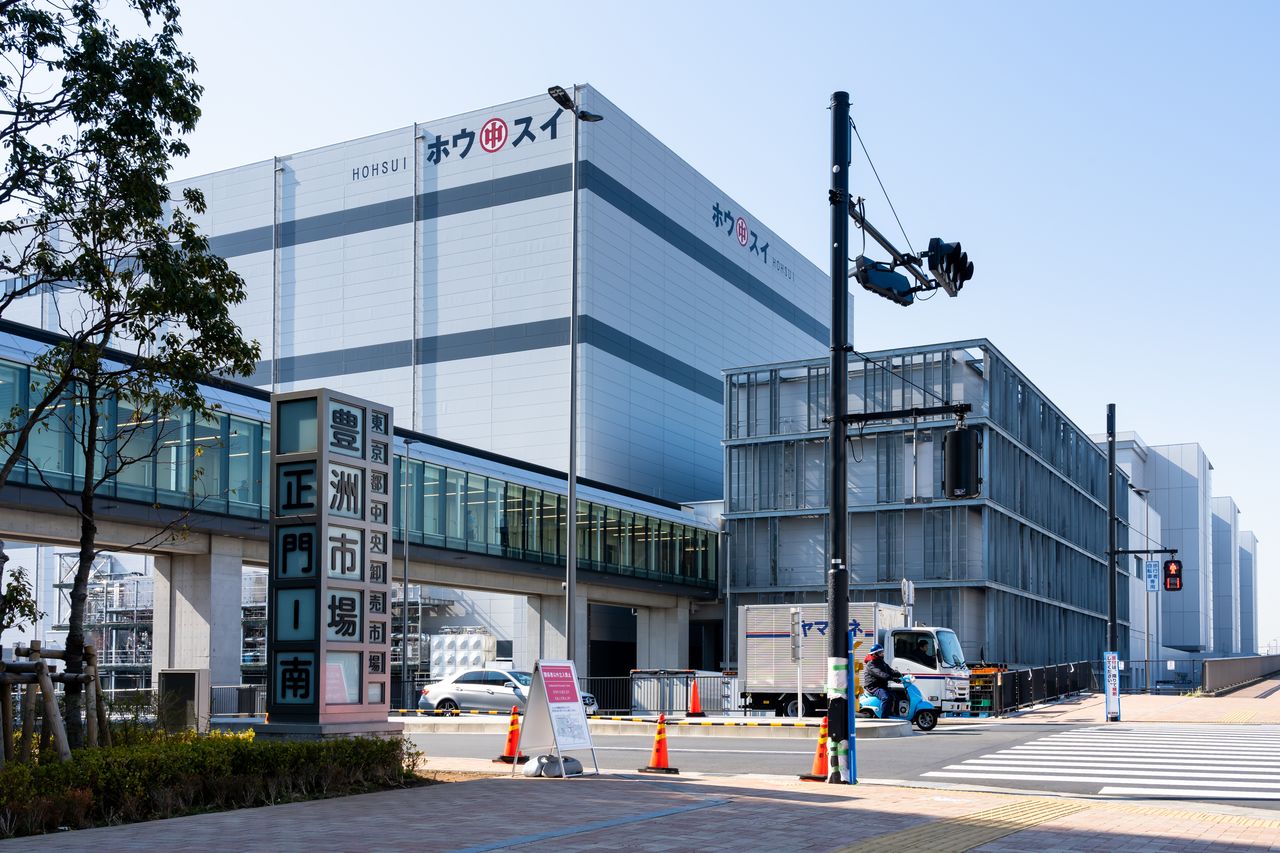
A walkway takes visitors from the management complex to the Fisheries Wholesale Market.
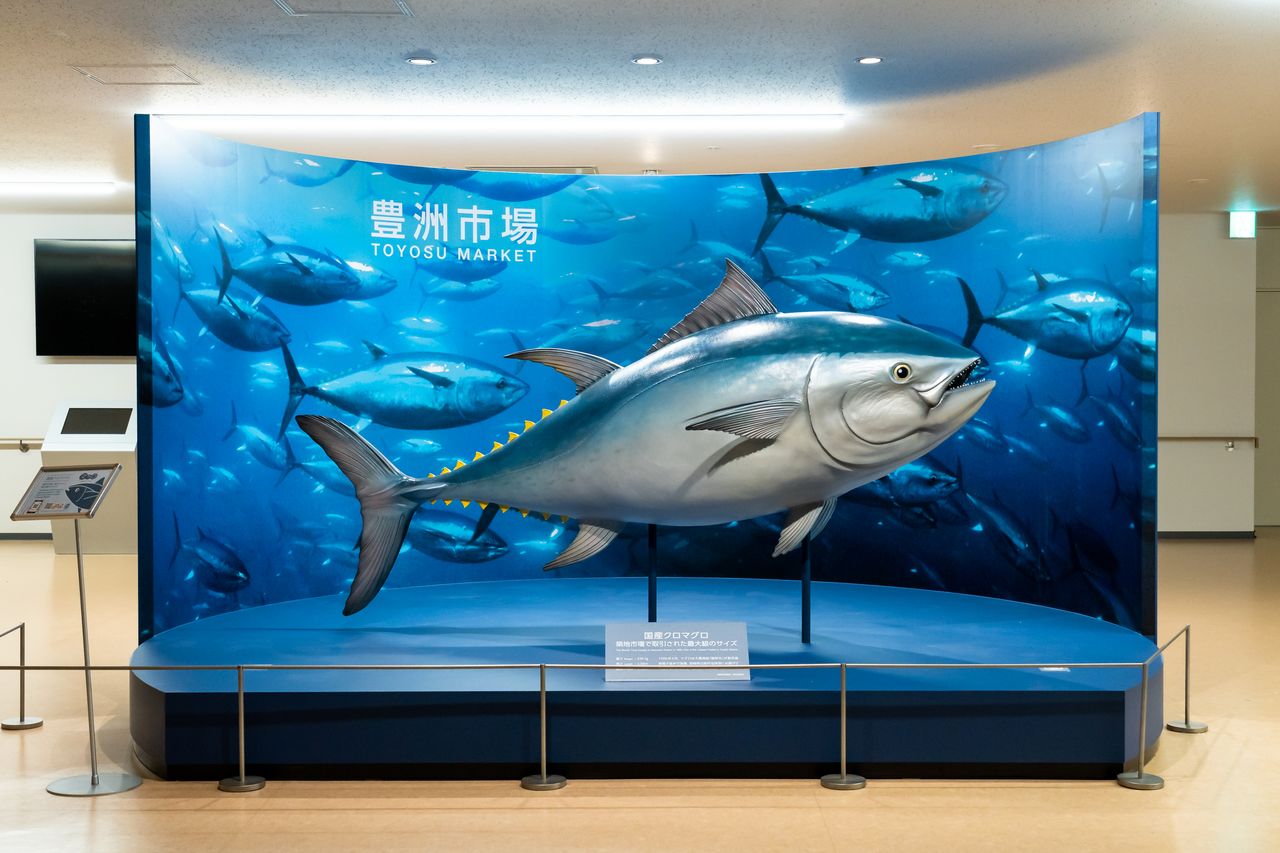
The giant tuna replica is a popular spot for souvenir photographs.
Just past these attractions are displays on market history, including photographs showing how the Nihonbashi Market was relocated to Tsukiji following the widespread descruction of the Great Kantō Earthquake of 1923. Windows in the left-hand wall of this area afford a view of the tuna wholesale floor, where white frozen fish are arrayed in regular formations first thing in the morning. Visitors are rooted to the spot, watching as closely as they can as tuna are auctioned off one by one.
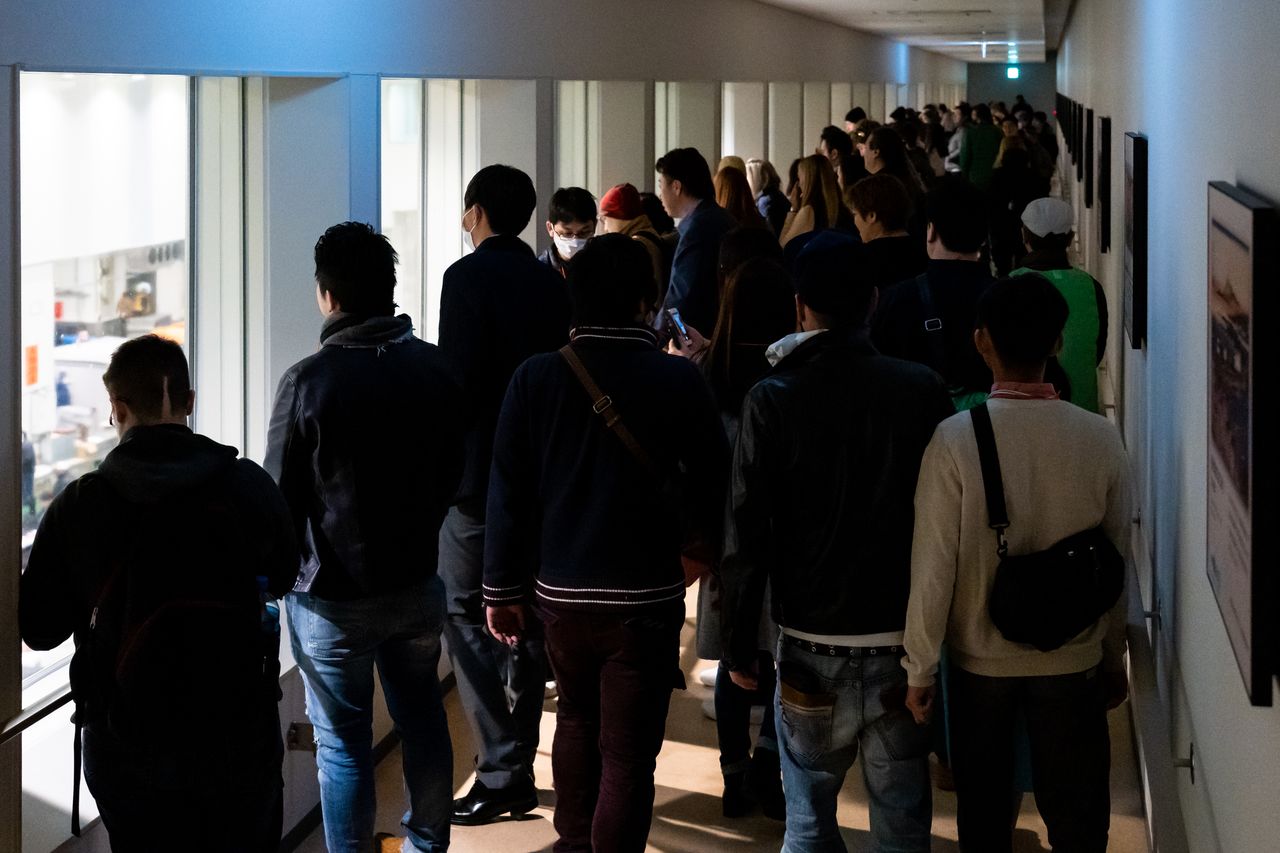
The second-floor walkway provides an observation deck for the tuna auctions. On the right-hand wall are photographs illustrating the history of the market.
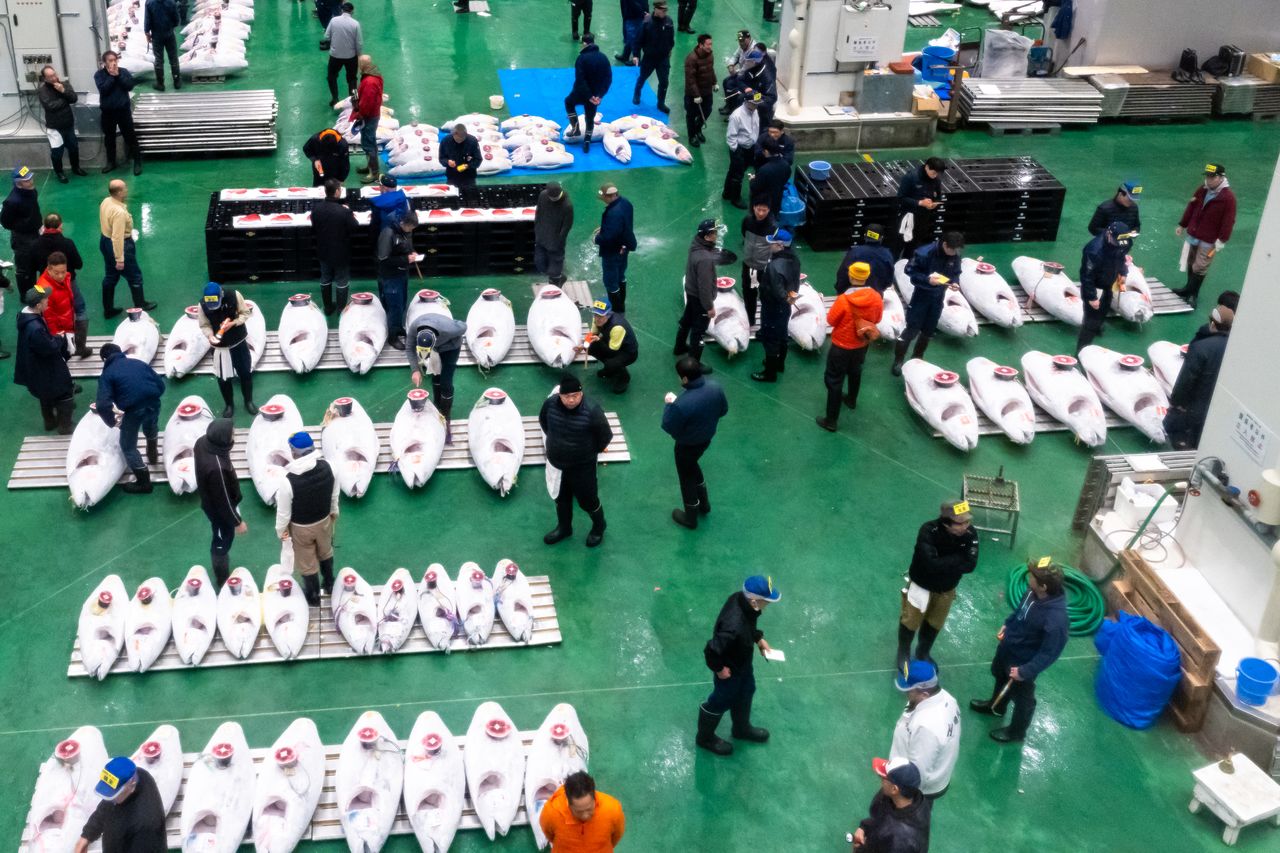
From the walkway, visitors can see rows of frozen tuna arranged on pallets for the daily tuna auction, which begins around 5:30 am. It is recommended that those who want to see an auction get there early (taking a taxi before the Yurikamome line begins running is one option), as the tuna get snapped up quickly once the bidding starts.
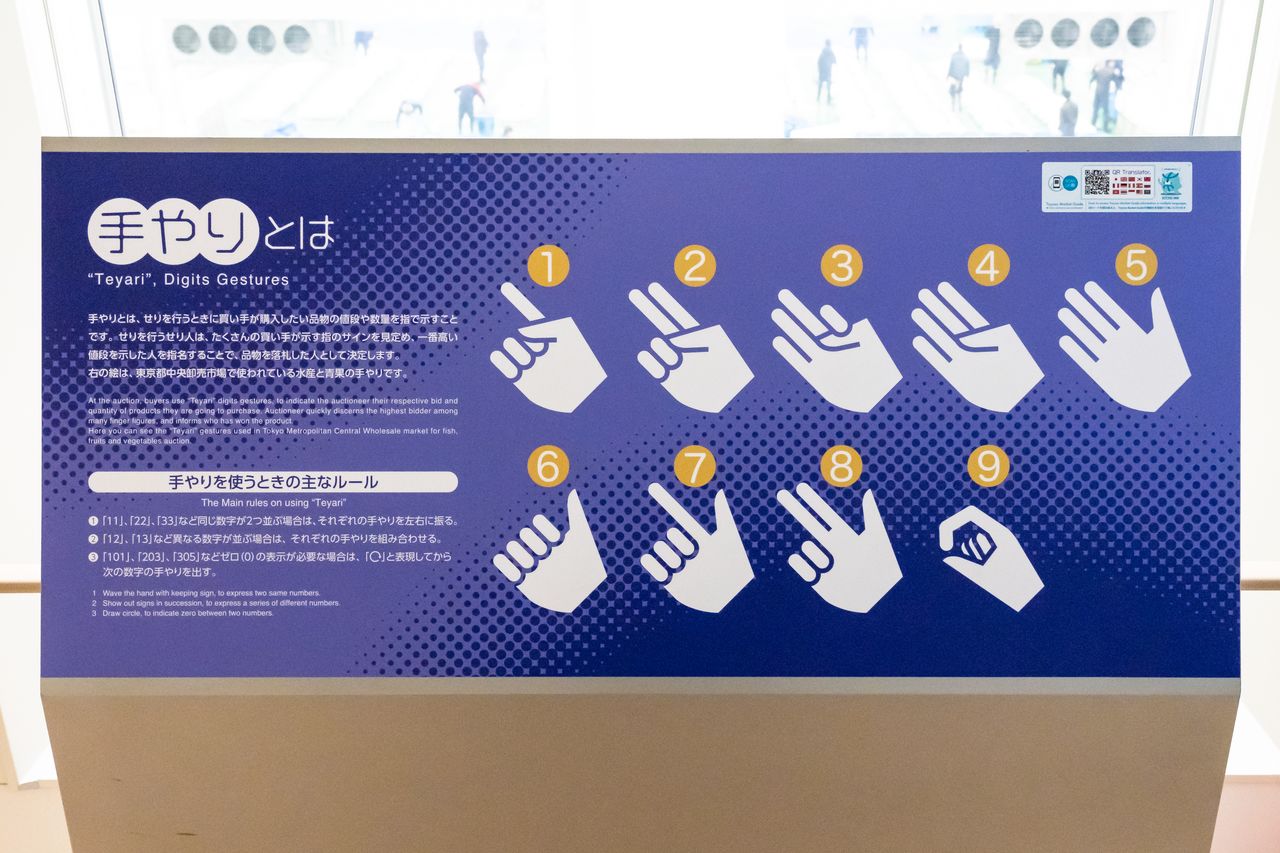
Bilingual information boards provide explanations of such procedures as the te-yari hand signals used by tuna buyers to place bids, further enriching the experience.
In addition to the observation deck on the walkway, another deck was opened just off the first floor in January 2019. Here, visitors can get an up-close look at the frozen tuna and other elements of the auction floor. Unlike a similar structure at Tsukiji, which was made available on a first-come, first-served basis, visitors wishing to use this deck at Toyosu will have to apply for spots on a reservation website (see the English link at the bottom of the page) set up for the purpose. Visitors enter their names and the dates they want to visit, typically at least two weeks in advance. If there are more than 120 applications for a given date, winners are determined by lottery. Visiting times are 5:45 to 6:15 am, with visitors allowed on the deck in two groups of 60 members each.
The deck is roughly 2 meters off the floor, allowing visitors to watch the auctions in even closer proximity than on the second-floor walkway. The front face of the first-floor deck is similarly partitioned off with glass, albeit with a small gap at the top. This gives observers a more up close and personal experience, allowing them to hear the sound of the bell that signals the start of an auction and the calls of auctioneers and bidders, as well as to smell the distinctive odors of the place.
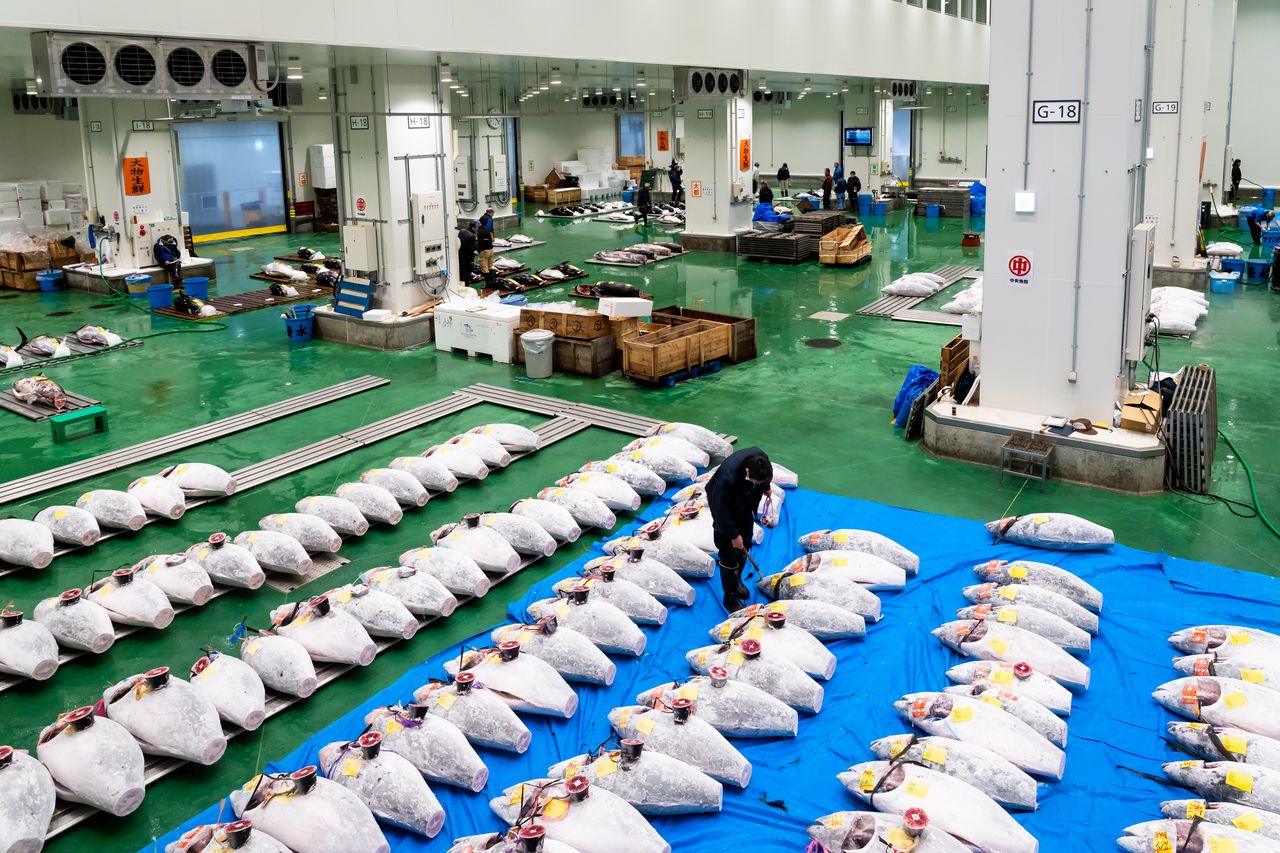
The view of the tuna auction floor from the first-floor observation deck. At far left are fresh tuna, not visible from the second-floor walkway.
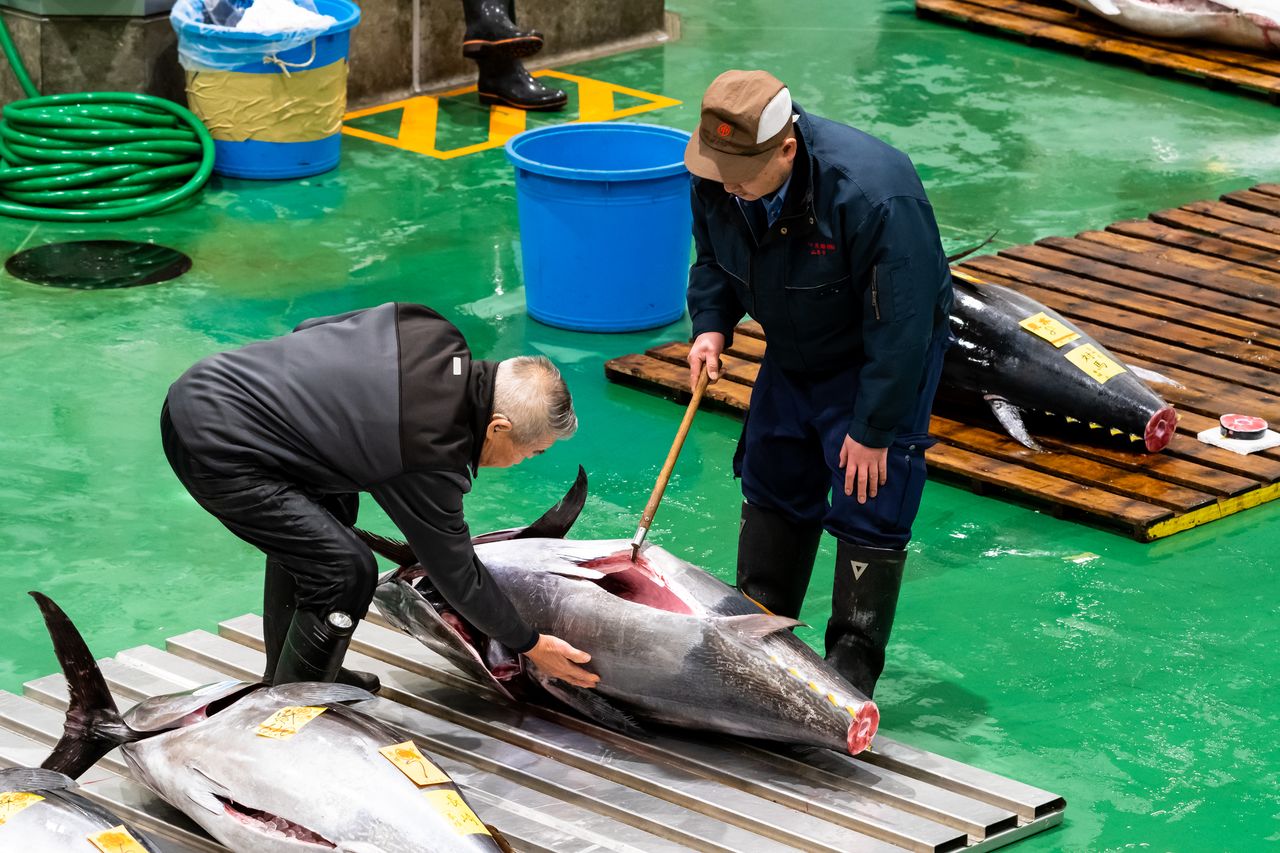
Brokers and dealers inspect the tuna with care prior to the auction.
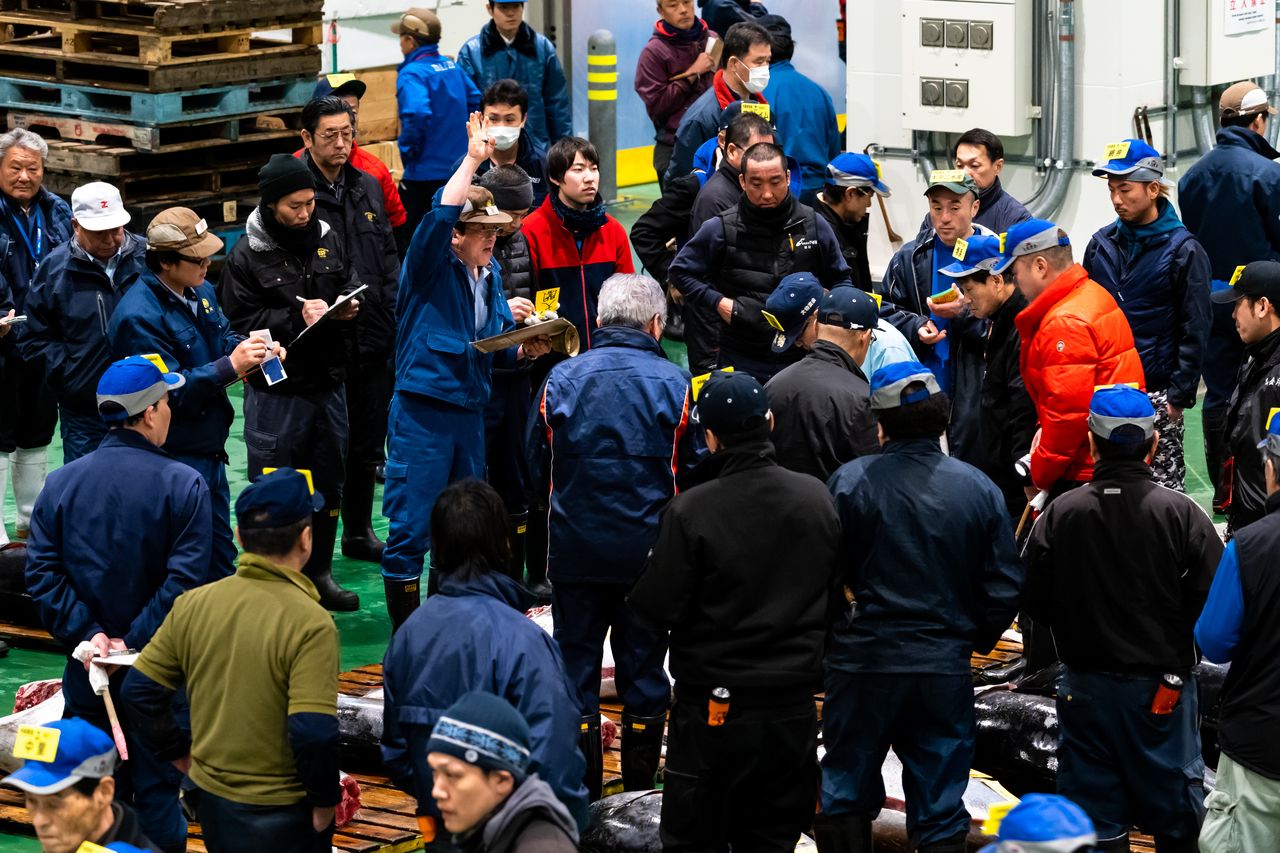
The auctions are lively: the price of a fish is typically decided every few seconds.
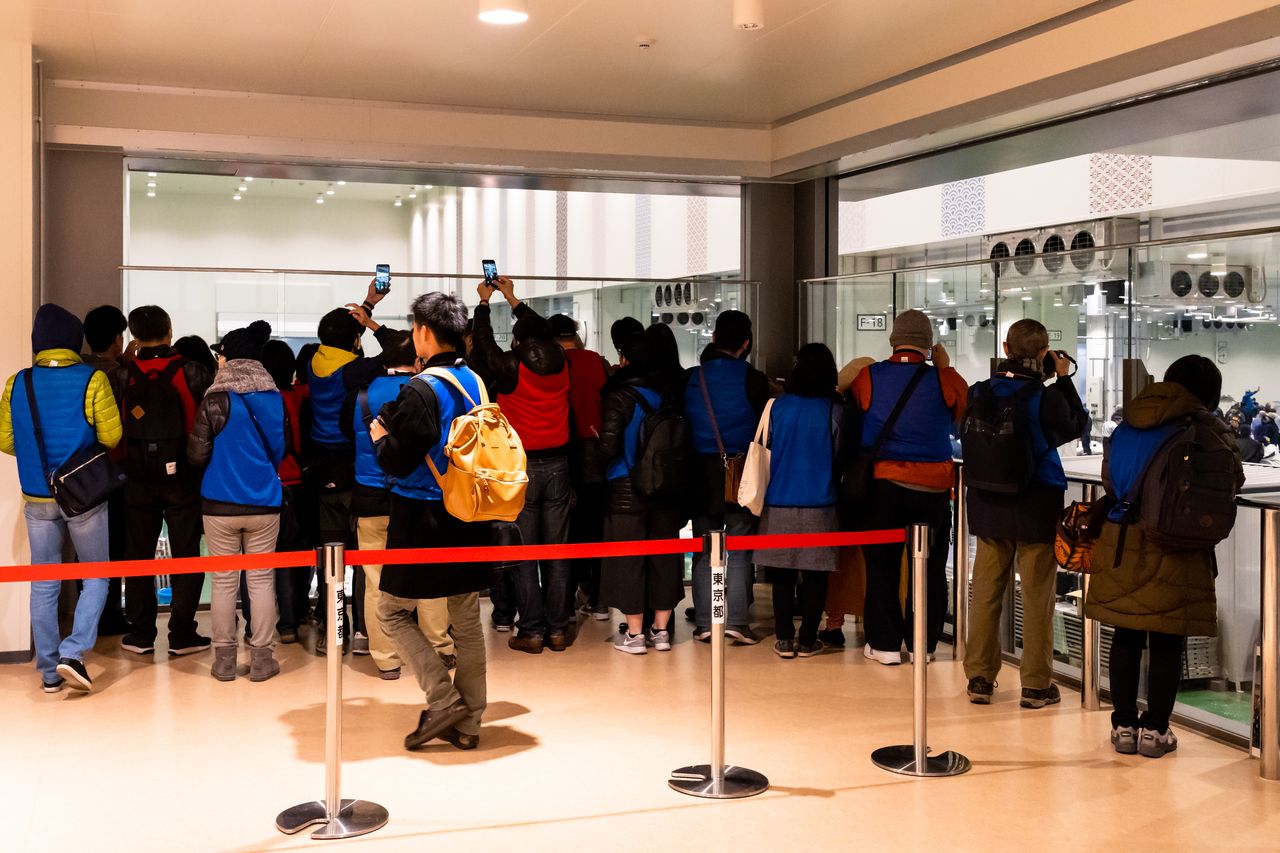
The glass on the first-floor observation deck does not extend all the way to the top, giving observers access to the sounds and smells of the auction.
Fine Cuisine and Professional Utensils Too
After the tuna auction, head back to the Management Facilities Building, then back out to the walkway leading to the Yurikamome train station. To the south is the Fisheries Intermediate Wholesale Market, with its third-floor dining area featuring over 20 restaurants, including eight sushi shops, in an area twice that of the restaurant area in the management facility.
Among the sushi restaurants in this section is Sushi-dai, which was considered one of the best when it was on the Tsukiji Market grounds as well. Other popular shops that have also relocated from Tsukiji offer tonkatsu, gyūdon (bowls of steamed rice topped with thinly sliced beef), Japanese curry over rice, and coffee shops. All of the sushi shop menus are as fresh and tasty as would be expected from their location on the market premises themselves. Prices range from ¥3,000 to ¥4,000 per person—not necessarily cheap, but still good value for quality, as acknowledged by the market’s workers themselves. All are highly recommended.
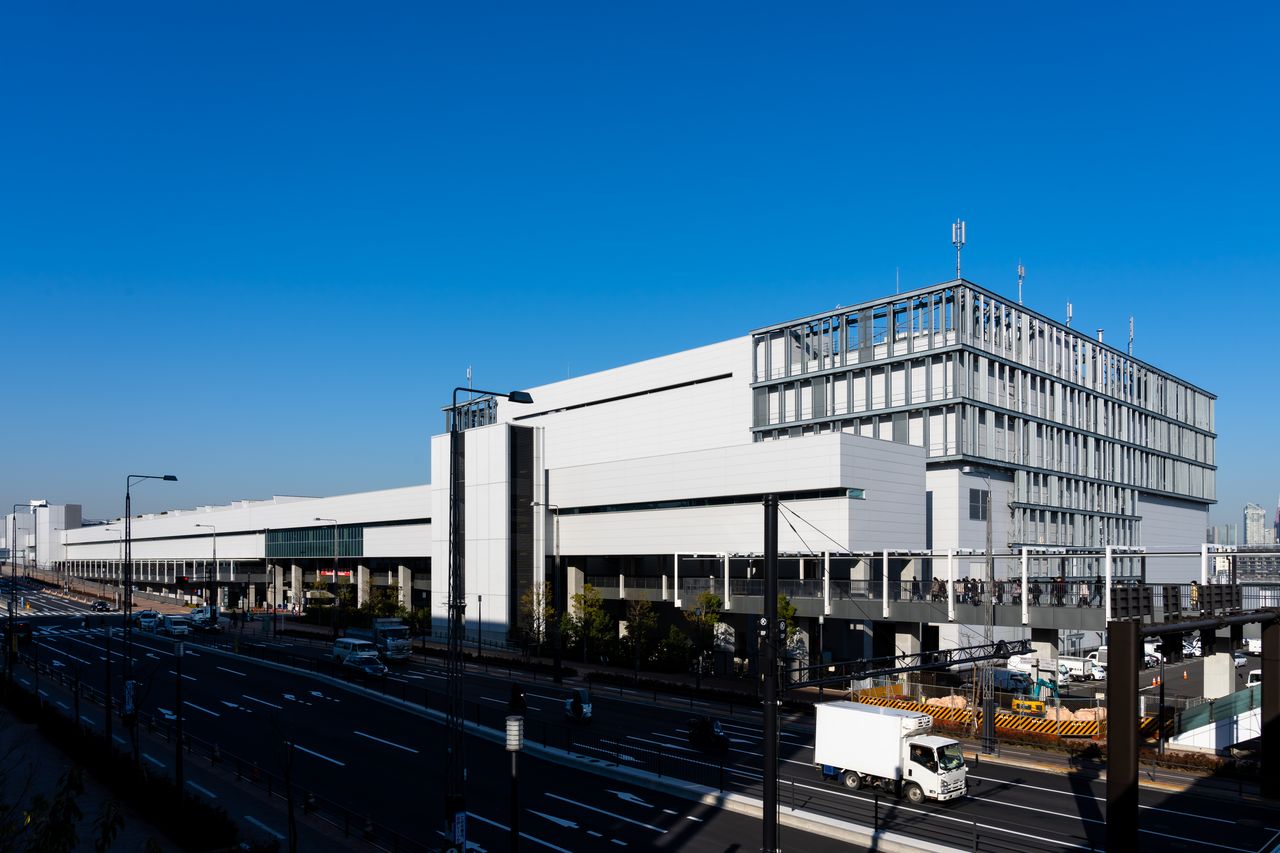
The giant Fisheries Intermediate Wholesale Market. The elevator at center left in the photo accesses the greenery area on the rooftop.
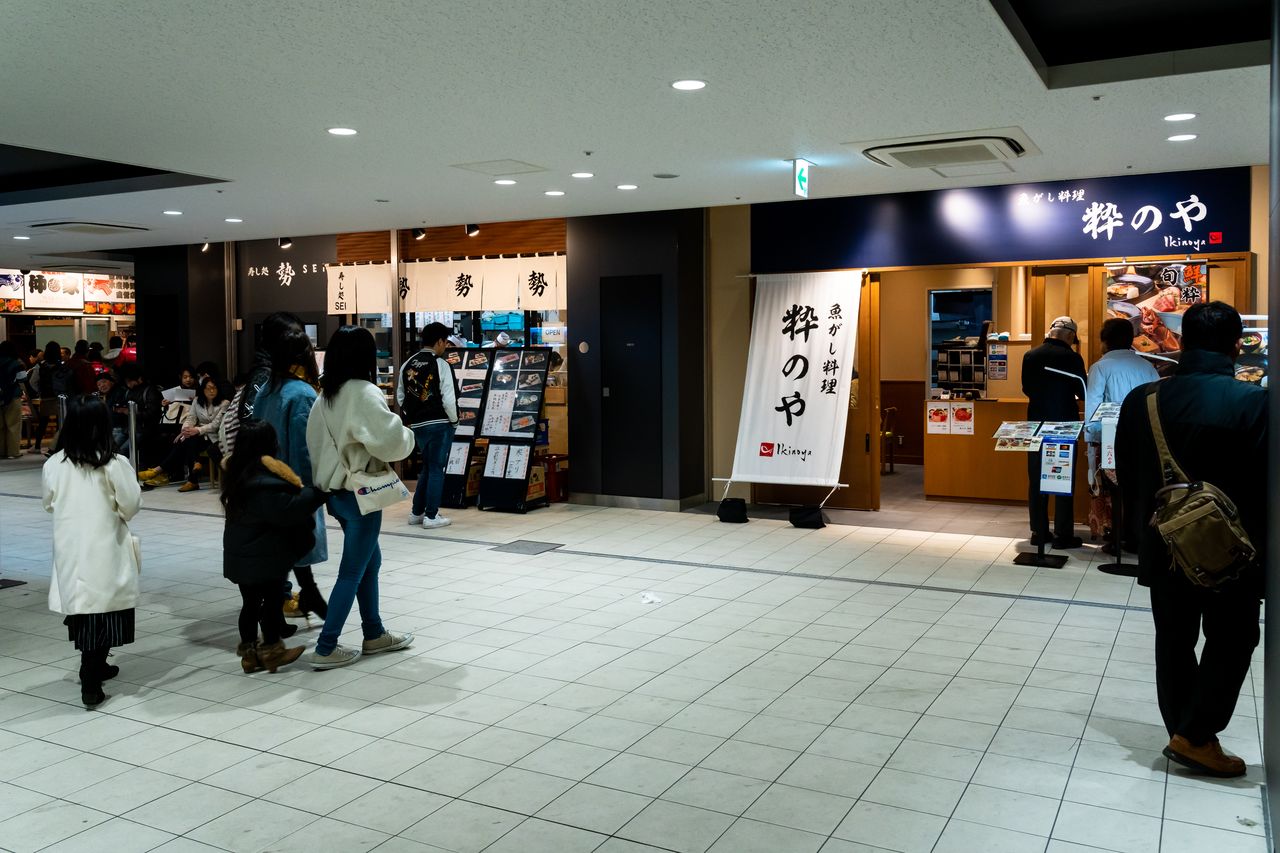
The intermediate market has a bigger restaurant area than that in the management complex, and is a common stop for tour groups.
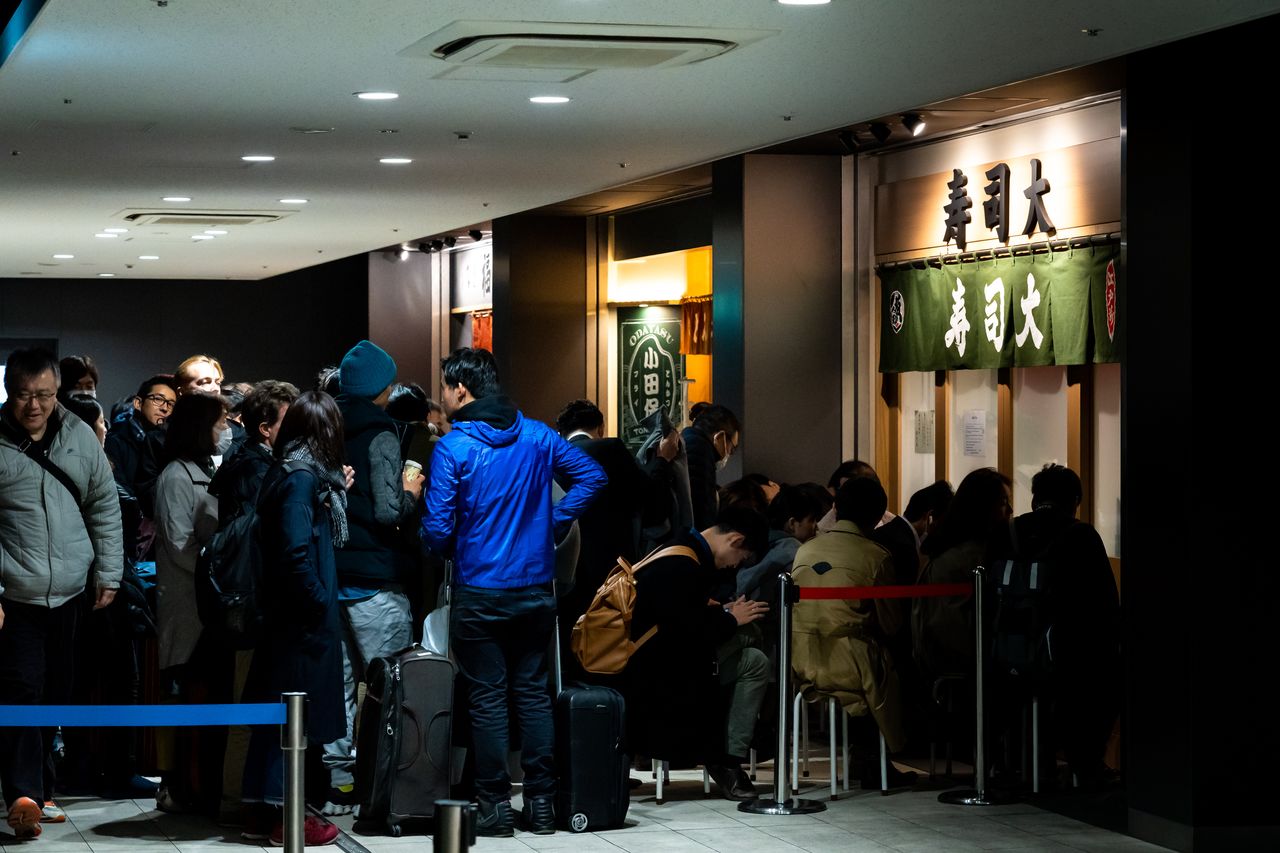
Crowds start lining up early in the morning at the popular Sushi-dai restaurant.
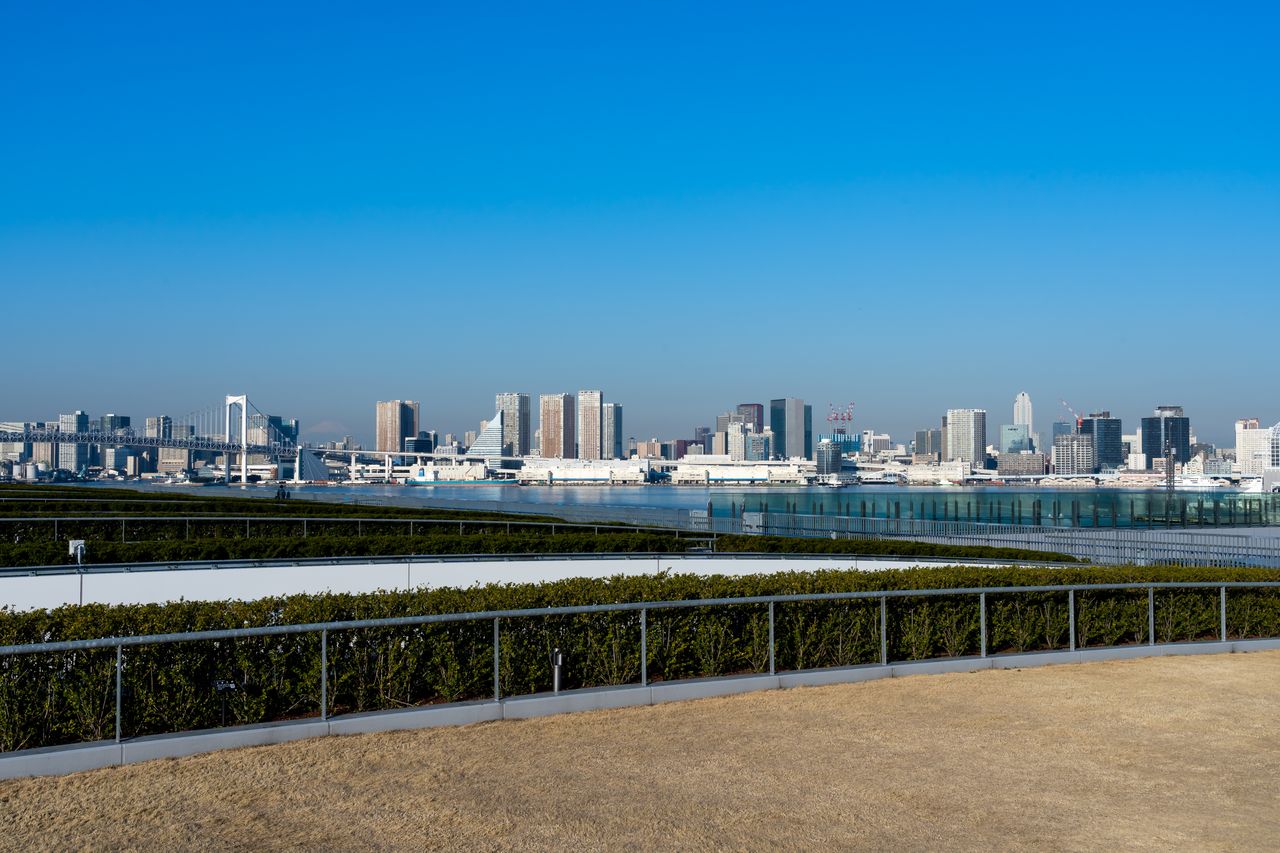
The rooftop greenery area is the perfect place to catch your breath after walking around the expansive market grounds, offering views of sights like Tokyo Tower and the Rainbow Bridge.
Farther along the walkway from the restaurant area into the Fisheries Intermediate Wholesale Marketis an observation gallery where visitors can take souvenir photos of themselves riding one of the turret trucks that transport goods throughout the market.
The fourth floor of the complex is set aside for Uogashi Yokochō, a shopping area catering primarily to restaurant chefs and other professionals. Other customers are also welcome to browse the wide selection of foods, utensils, and other items.
A wide range of foodstuffs is on offer, including everything from wasabi and tsukemono (pickled vegetables) to tamagoyaki (Japanese-style rolled omelettes), dried nori seaweed, and soup-stock-related products like konbu (kelp) and katsuo-bushi (dried bonito). The outlets stock all manner of necessities for Japanese restaurants. Other stores carry merchandise not procurable through Toyosu’s wholesalers, including beef, pork, and other meats. Still other stores specialize in spices, alcoholic beverages, rice, and many varieties of cheese.
There are also professional supply stores offering everything from the high-grade knives used by cooks to the rubber boots that are essential wear in fish markets. Items that were popular during the Tsukiji days—such as dishware, packaging, and the noren curtains that traditionally signify that a Japanese shop is open for business—are available here, too, due to popular demand. These stores also sell to nonprofessional customers who want top-quality products to put to use in their own households.
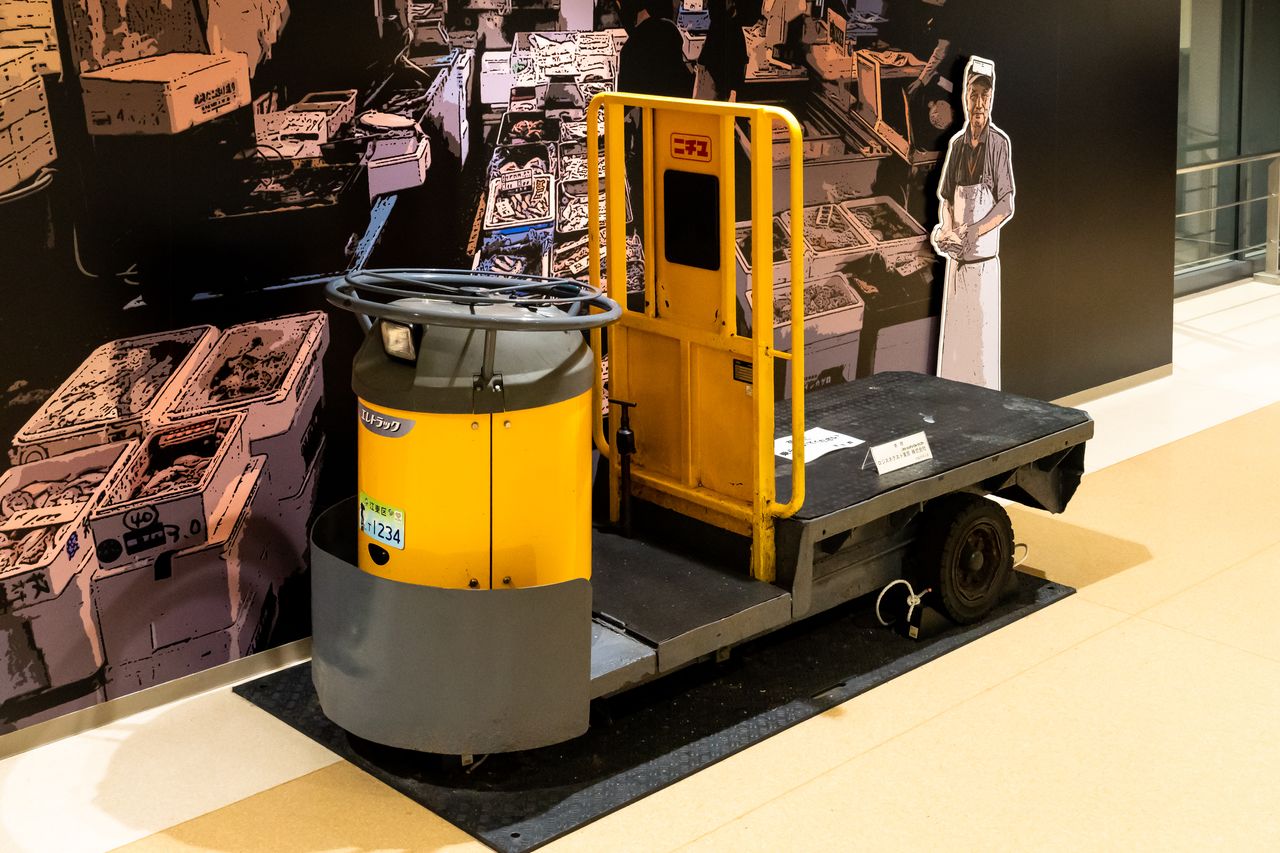
This turret truck is located in the visitor’s gallery in the Intermediate Wholesale Market. Visitors can climb on and pose for souvenir photographs.
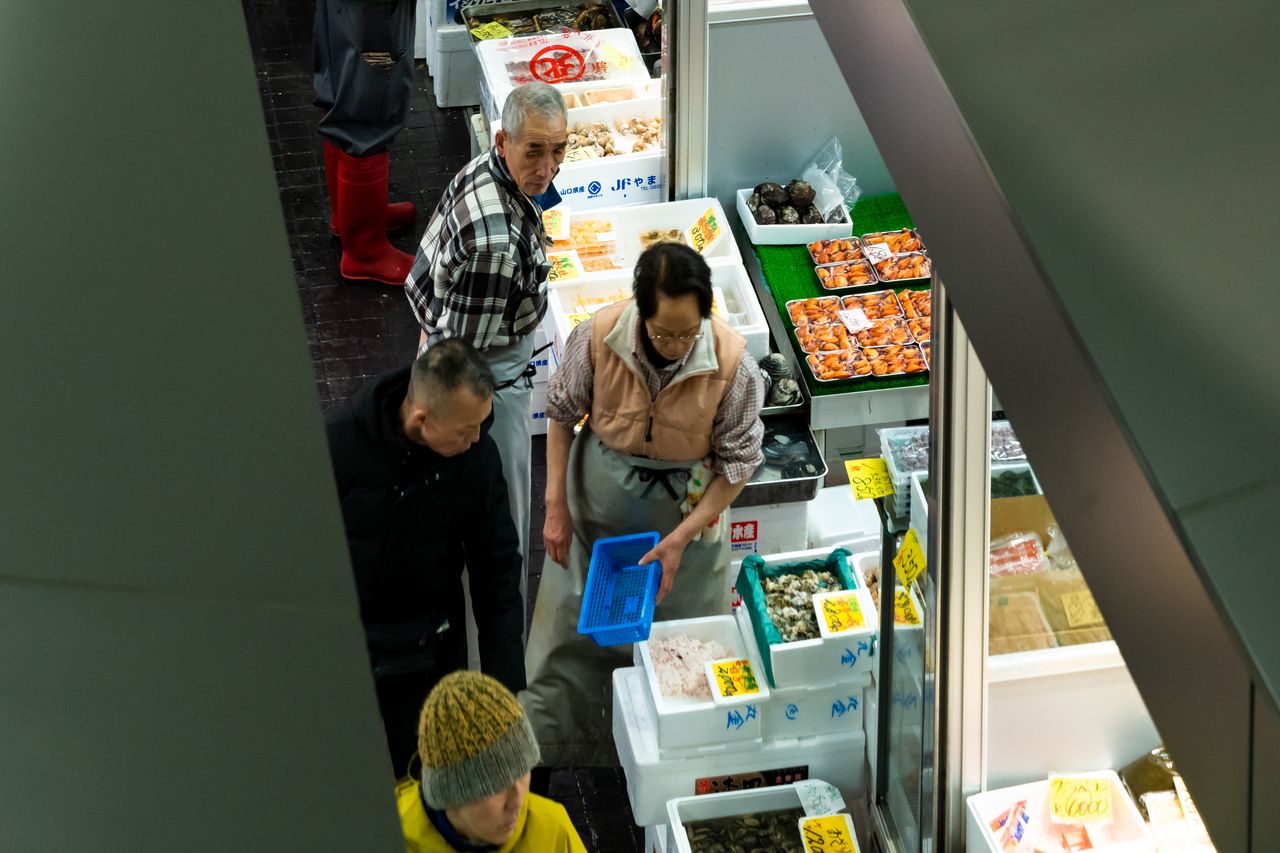
An observation gallery offers a glimpse of the action on the market floor.
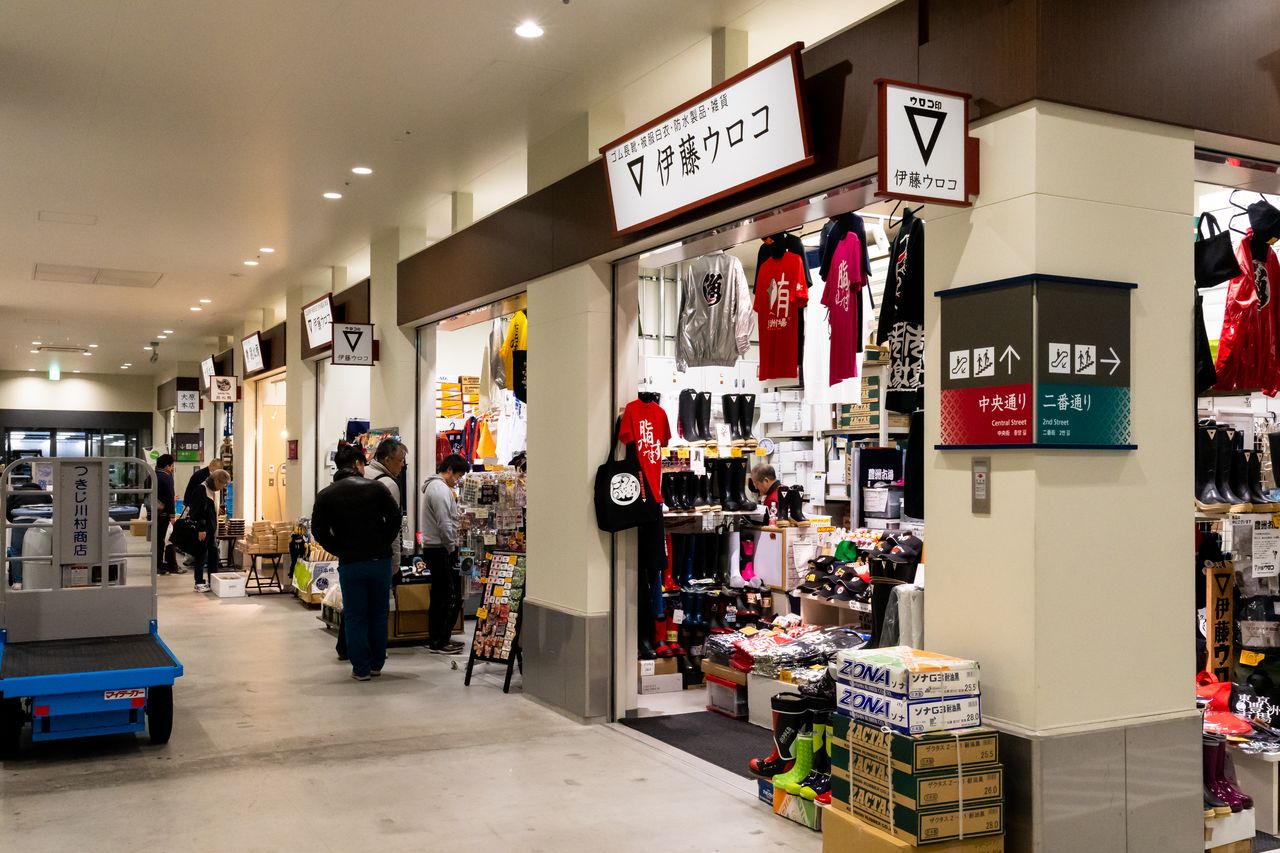
Uogashi Yokochō offers professional-grade foodstuffs, cooking utensils, and tools of various trades.
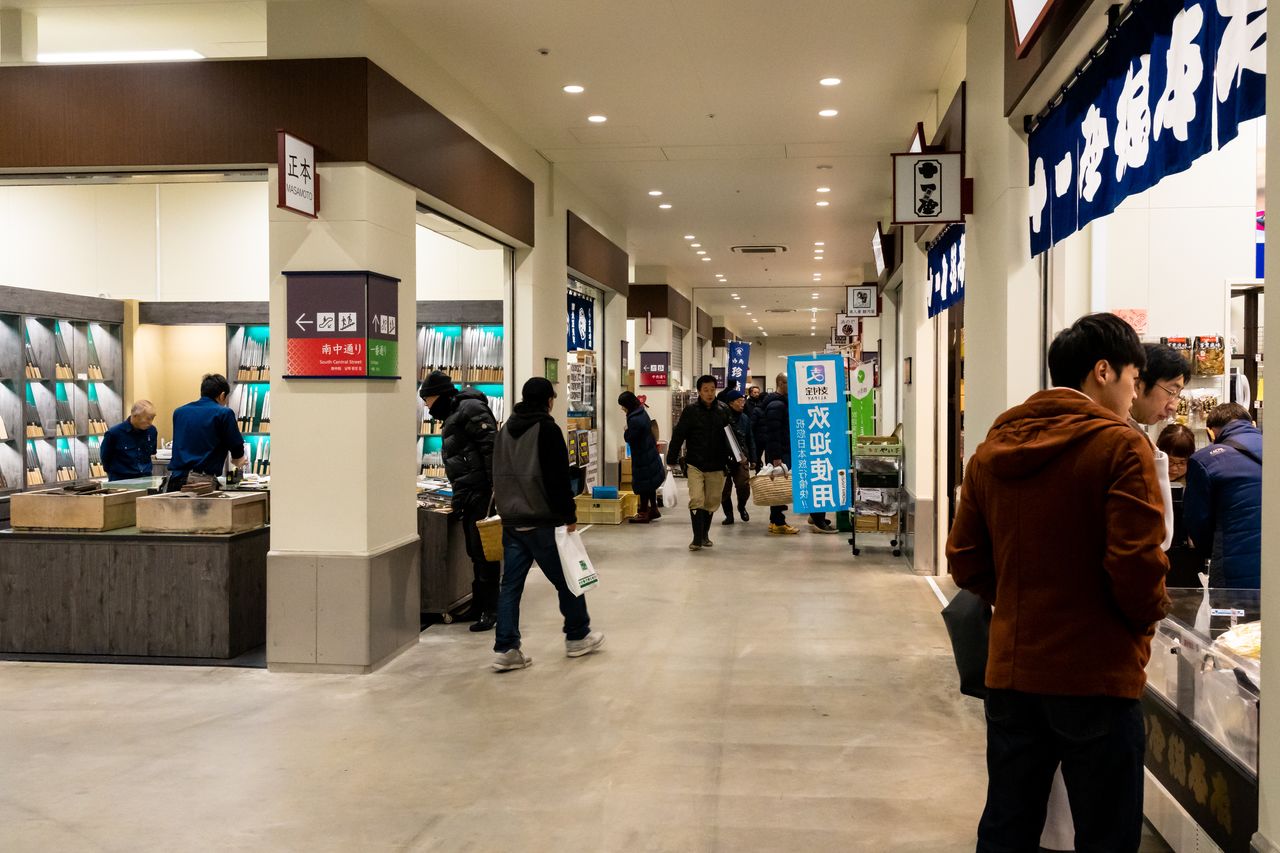
Also on sale here are a full range ofg professional-grade kitchen knives, tamagoyaki (Japanese omelettes) for snacking while walking, and t-shirts and caps, which make fine souvenirs.
Seafood and Produce for Sale
The brokerages active at Toyosu Market are essentially wholesalers, and retail sales of fish to general customers are not allowed. There are, however, events held at the market where visitors can go shopping for fish to eat.
On Saturdays through the end of March 2019, an event was held in front of the Fruit and Vegetables Building in Block 5 called the “Tasty Saturday Market.” Here, visitors could buy fresh seafood straight from the market, as well as high-quality fruit and vegetables that had been shipped there directly from where they had been grown. Popular restaurants also offered special weekly menus available only at the market through TLunch, the largest food-truck platform in Japan. All of this combined to bring ever bigger crowds to the market. Beginning in April 2019, similar events will take place on open grounds adjacent to the Intermediate Wholesale Market.
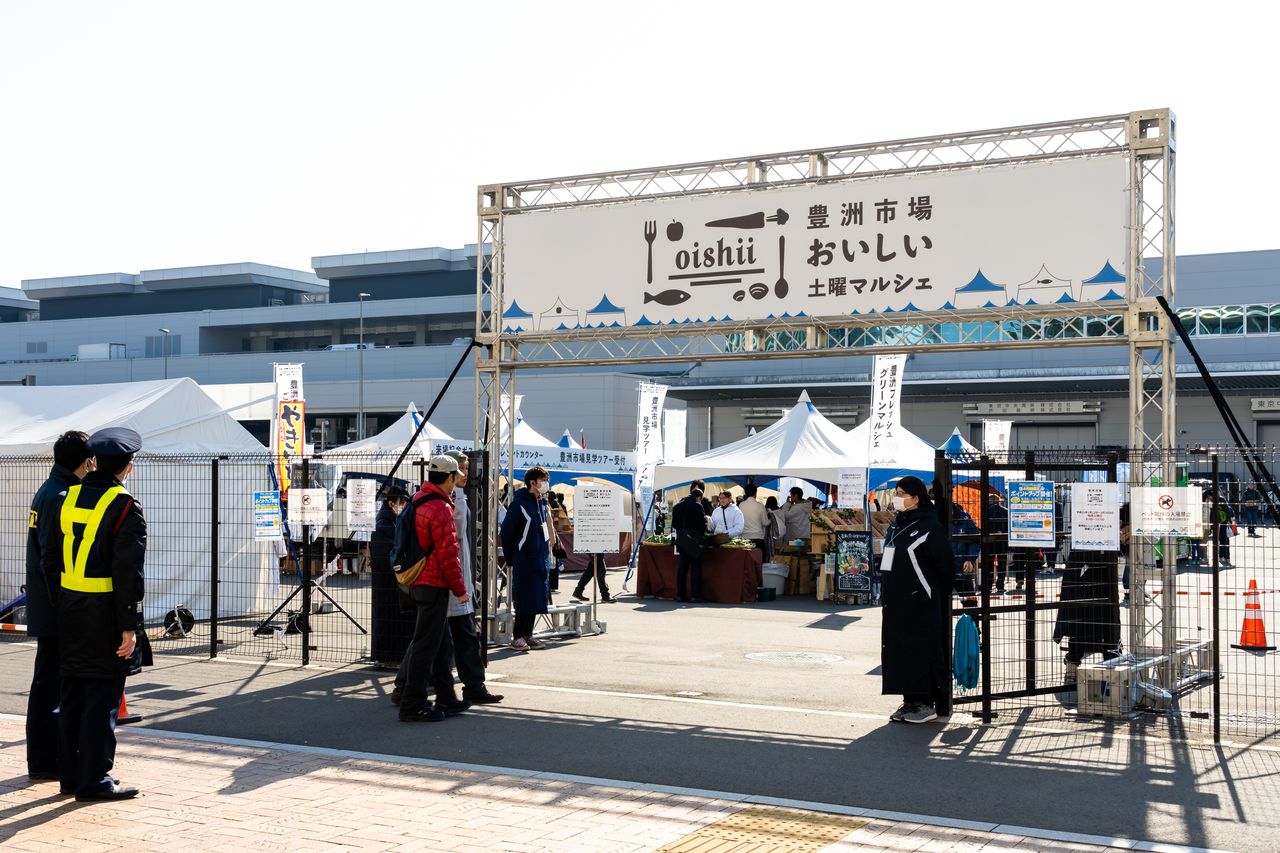
The entrance to the popular Saturday market.
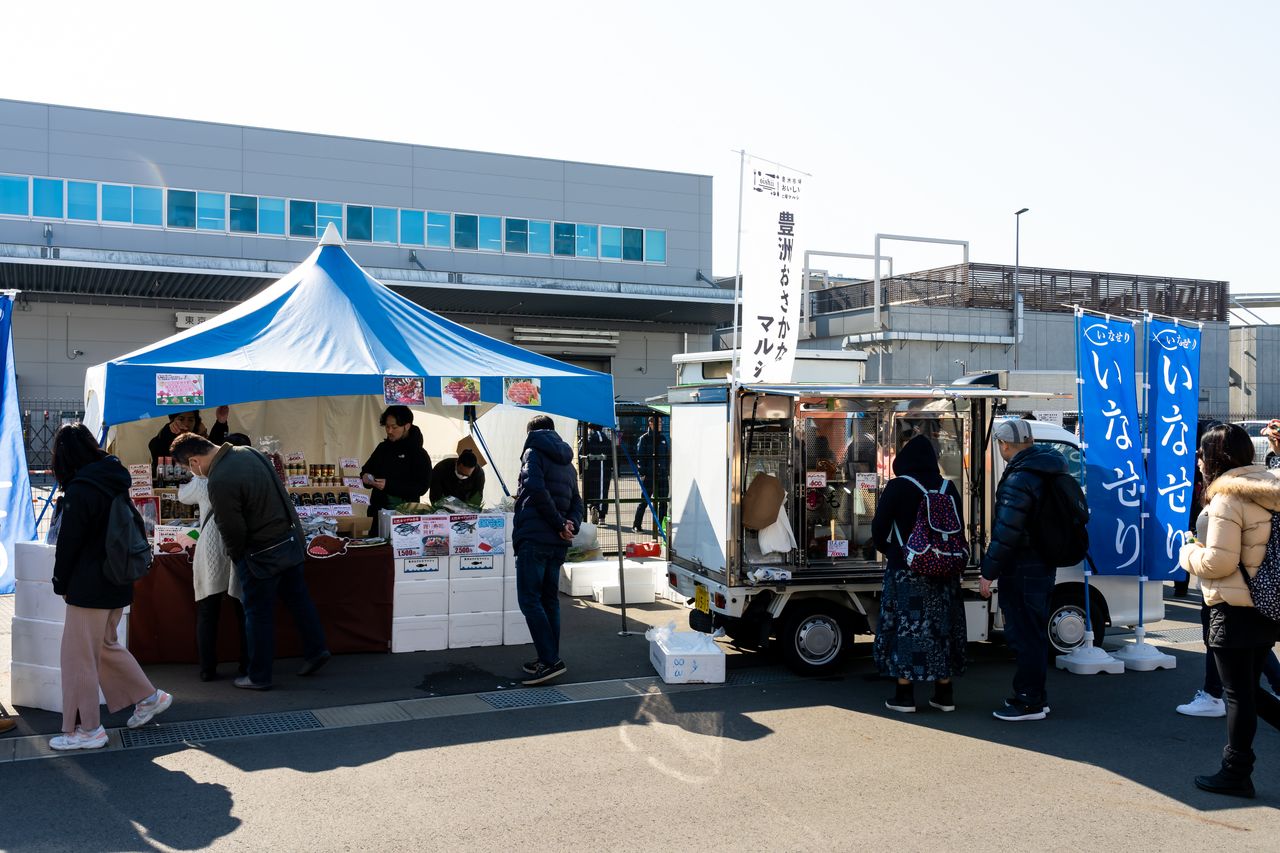
Fresh seafood was a big draw at the market events.
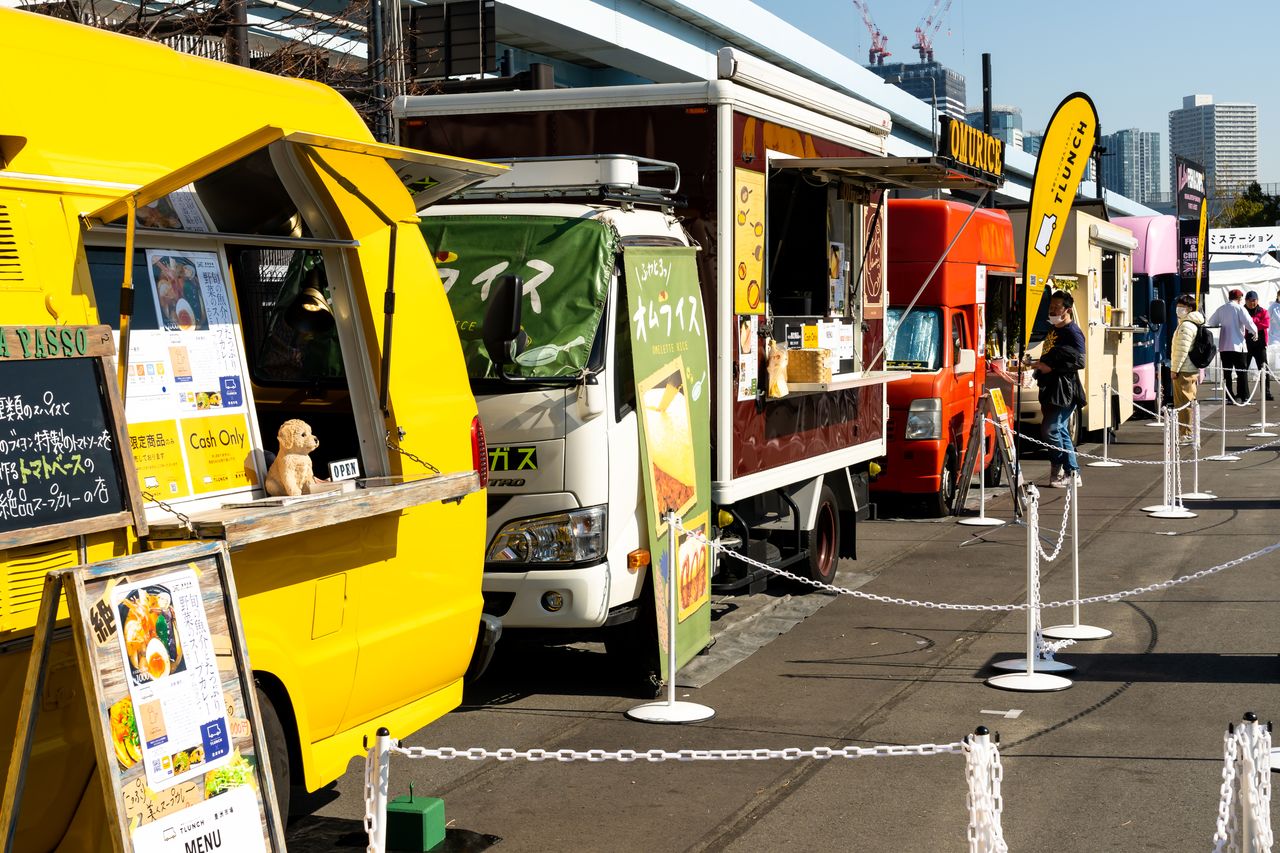
The TLunch food trucks gave customers another way to enjoy cuisine made with ingredients right from the market dealers.
The Fruit and Vegetables Building a very modern structure, features 12 glass panes on the visitor’s walkway near the entrance. Each of these is painted with the colors of fruits and vegetables that are in season for each month of the year. Around the corners are presentation panels, and at the farthest end is an observation deck with glass walls. Here early risers can observe the produce auctions held here. There are also three restaurants below the walkway to this complex, including Daiwa-zushi, a sushi shop that’s just as popular as the celebrated Sushi-dai, drawing similar crowds beginning early in the morning. More than a few market personnel vouch that Daiwa-zushi serves the best sushi on the market grounds, and has since the Tsukiji Market era.
Toyosu Market is a place for touring, dining, and shopping, whether you have made reservations for its attractions or are making a spur-of-the-moment visit. With all it has to offer, its popularity seems set to further increase.
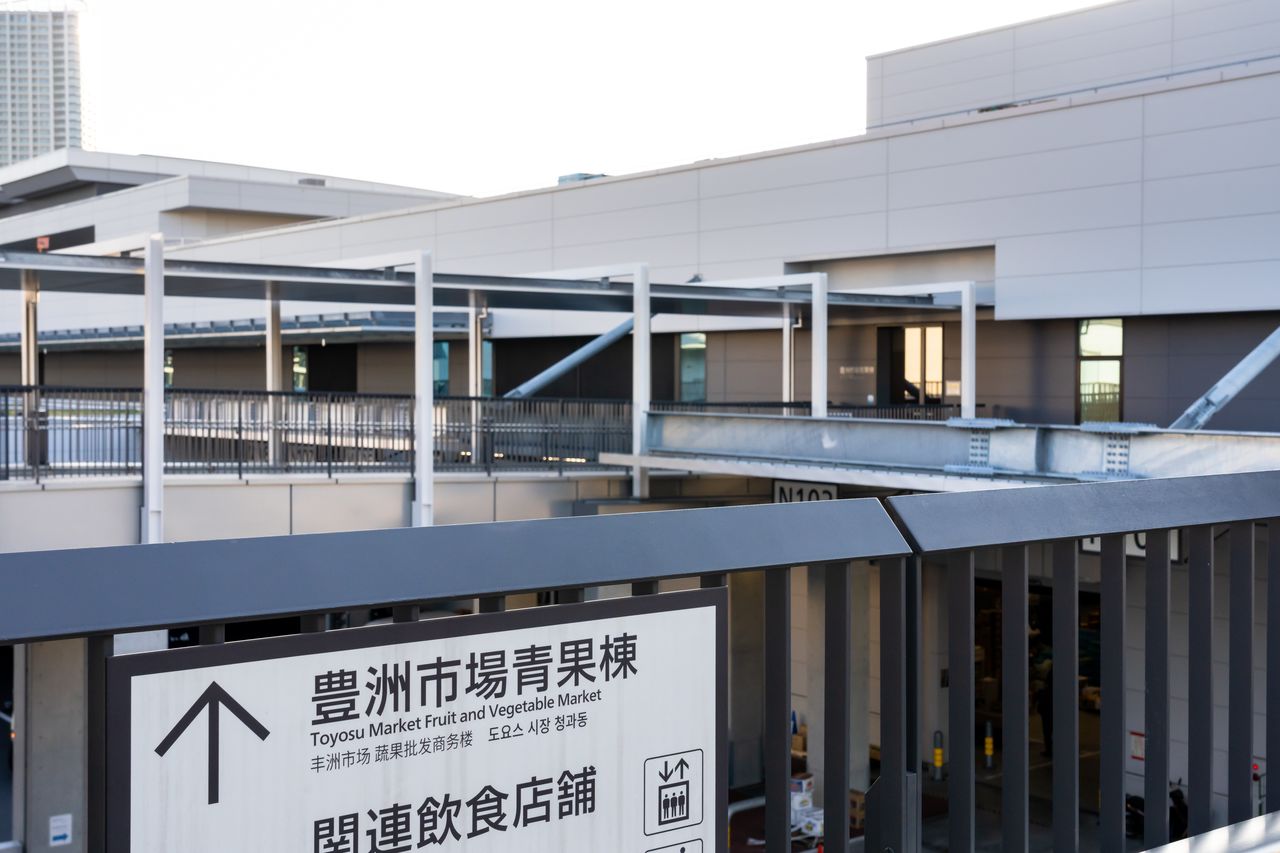
The Fruit and Vegetables Building, on the east side of Toyosu Market.
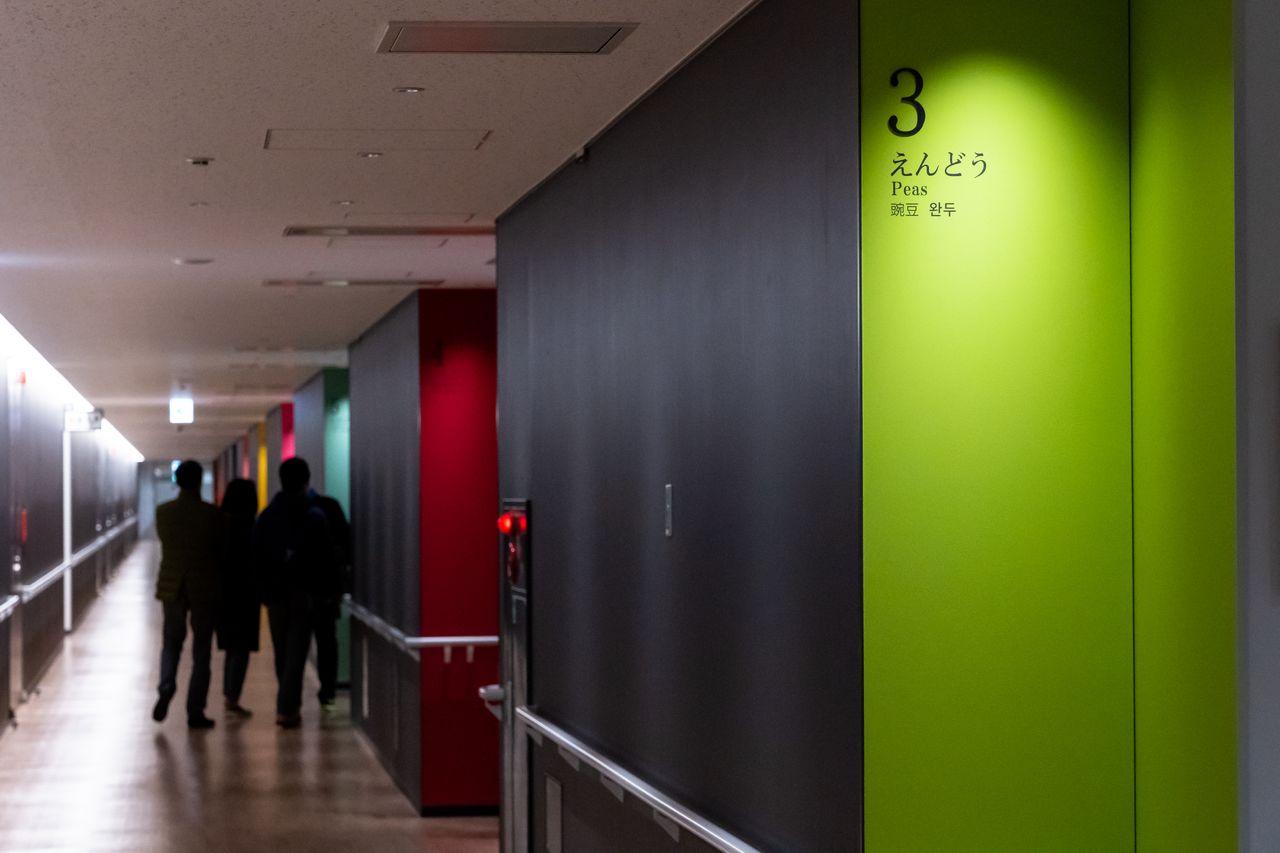
The colorful visitor’s walkway. Around the corners are presentation panels telling the history of the produce market.
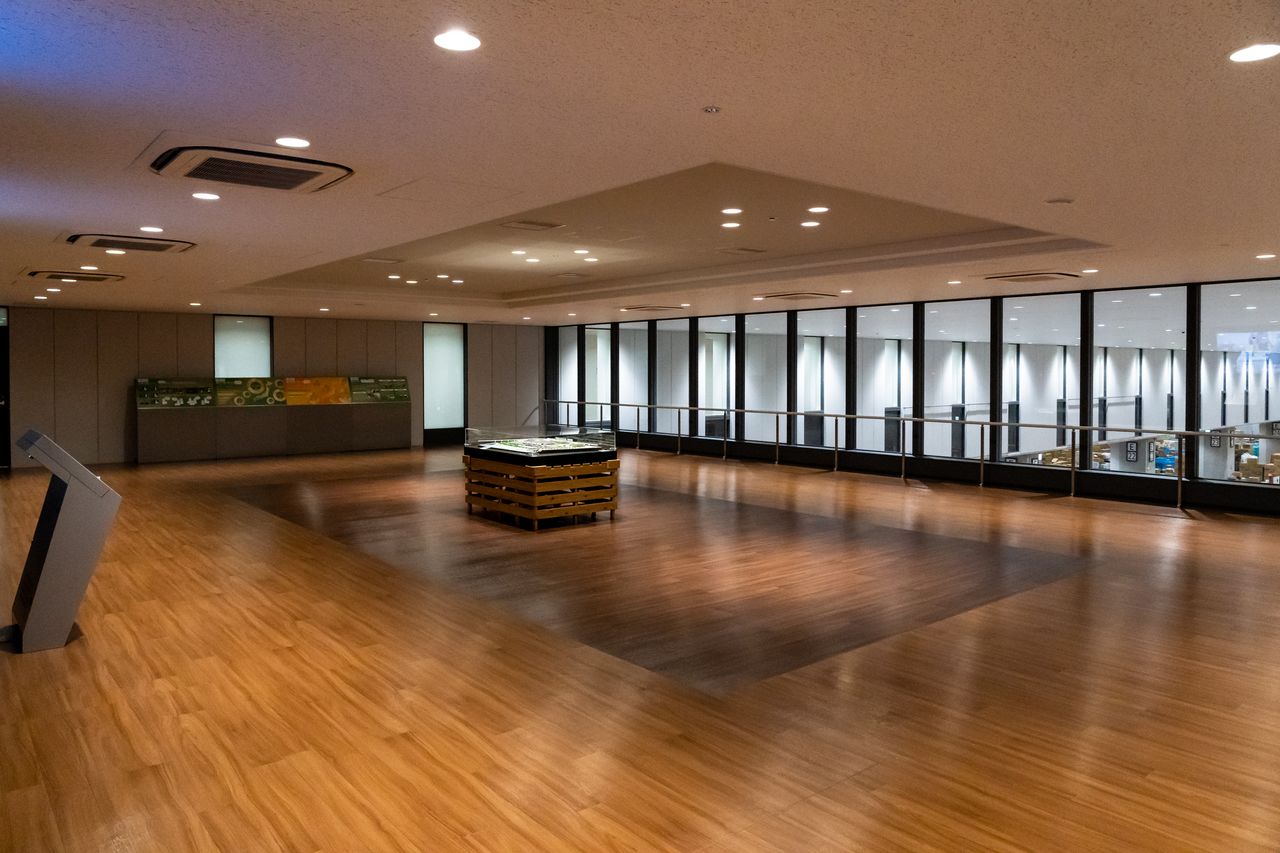
The visitor’s tour of the produce complex leads to a spacious, clean observation deck. In addition to offering a view of the Produce Wholesale floor, the deck also offers informative displays and videos.
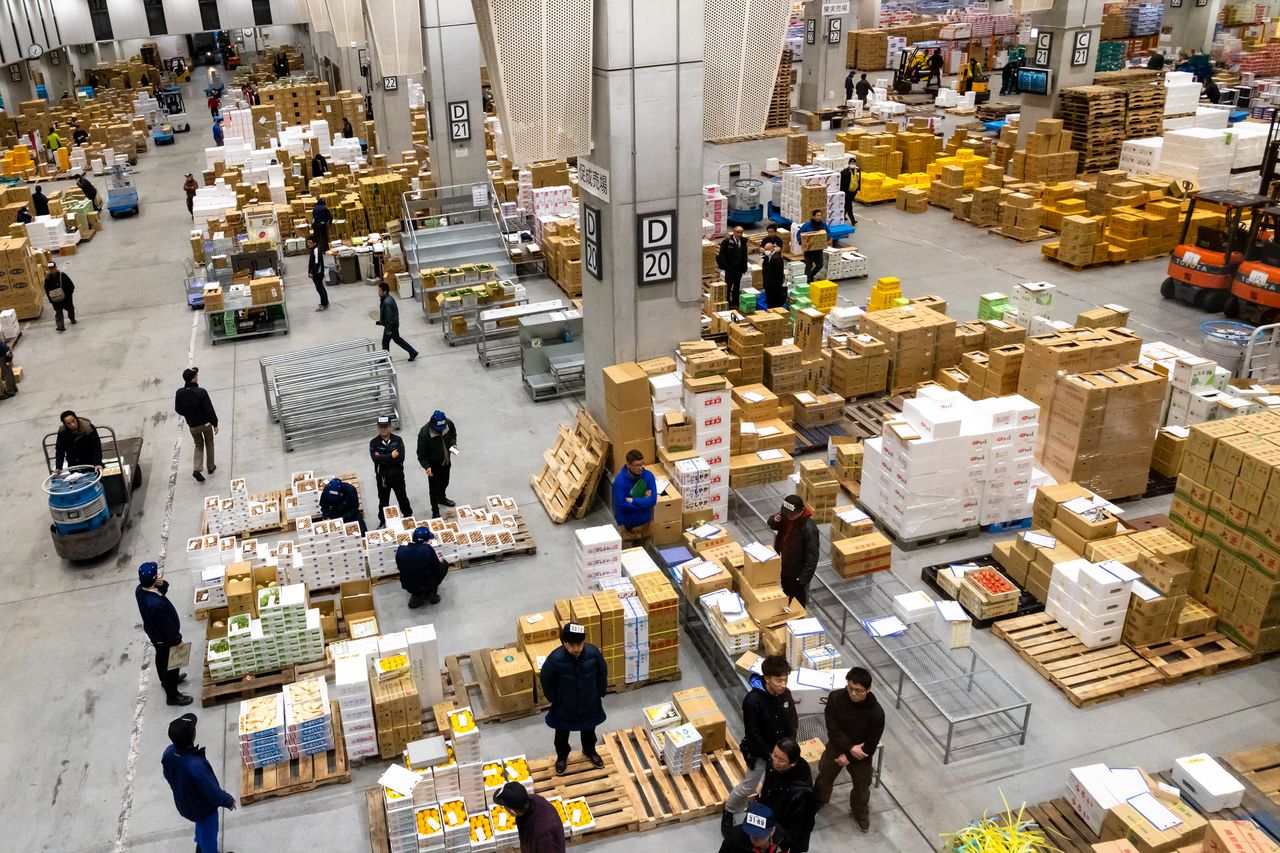
The produce wholesale floor is also extensive, with turret trucks going every which way.
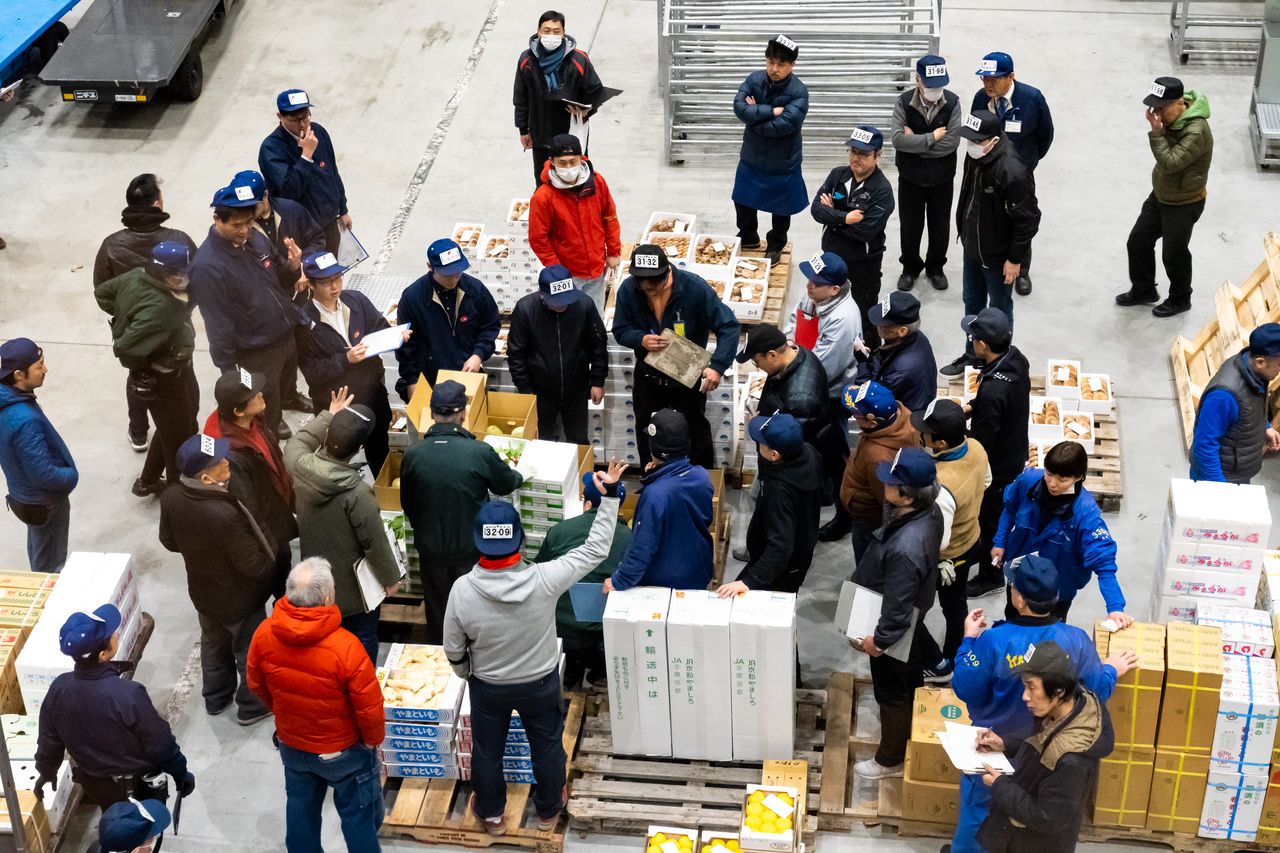
A produce auction as seen from the observation deck.
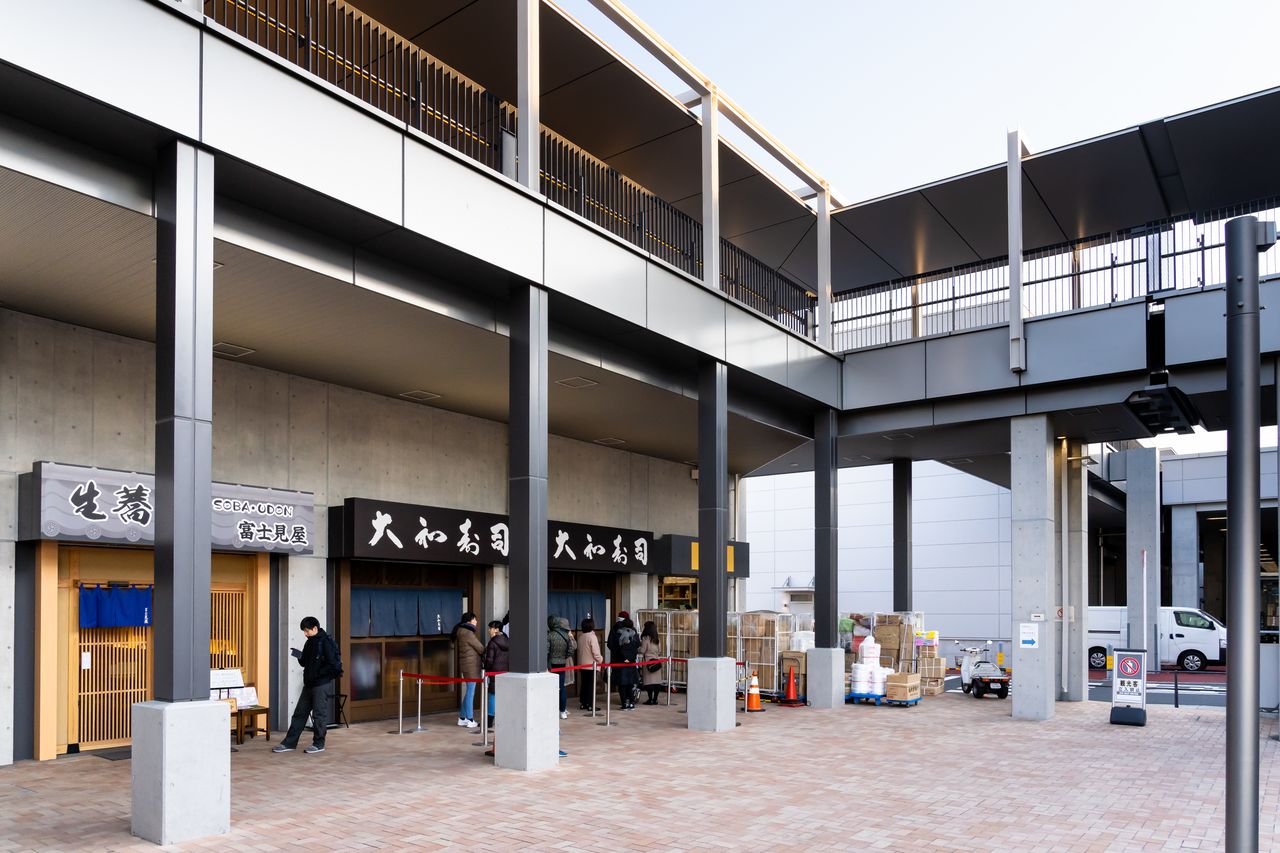
The outdoor restaurant and shop area of the Fruit and Vegetables Building, with a line forming outside Daiwa-zushi.
Access: Around 4 mins. from Toyosu Station or approx. 28 mins. from Shinbashi Station to Shijō-mae Station on the Yurikamome train line, then a short walk.
Refer to the official website of the Tokyo Central Wholesale Market for information on days when the market is closed.
http://www.shijou.metro.tokyo.jp/english/toyosu/index.html
(Originally published in Japanese. Text by Kawamoto Daigo, head of the department covering fisheries at Jiji Press. Photos by Miwa Noriaki. Banner photo: A replica of a giant bluefin tuna at the Fisheries Wholesale Market Building.)
